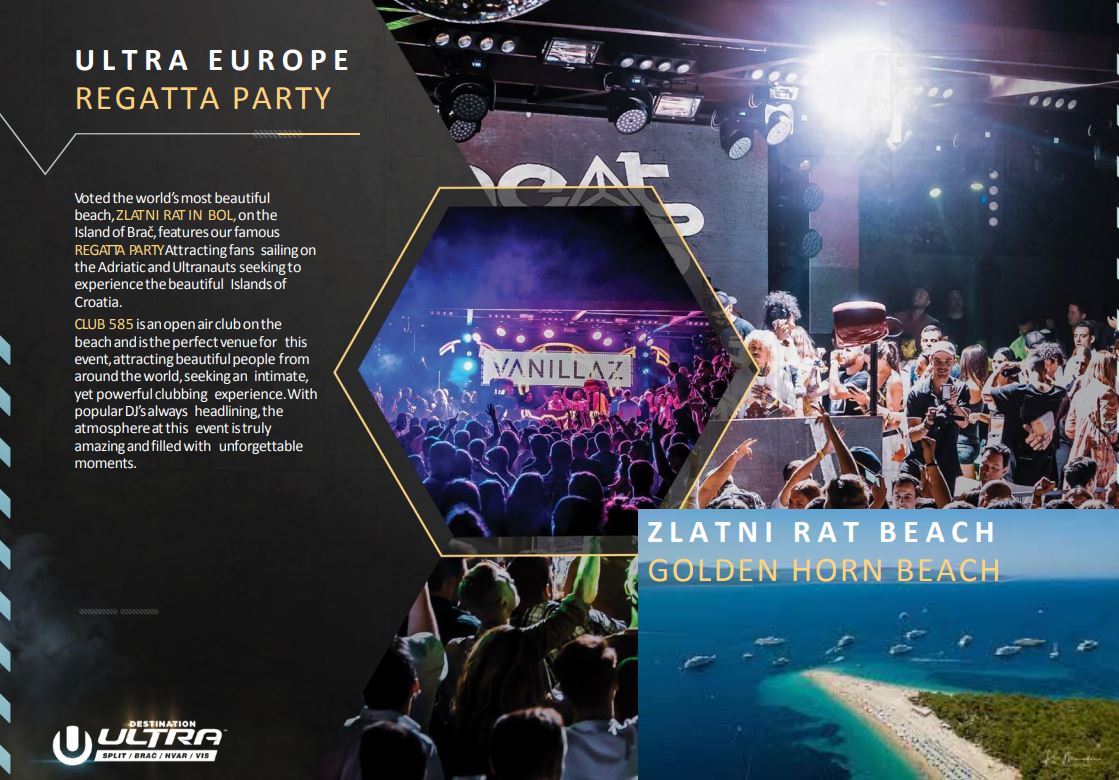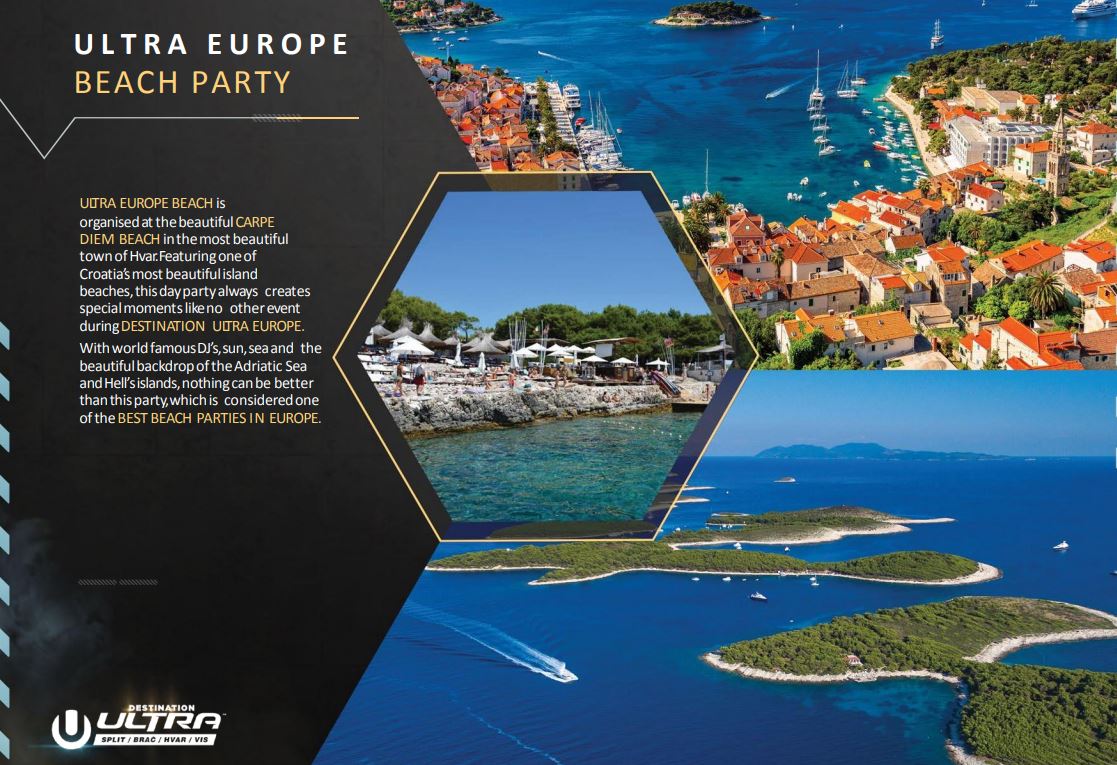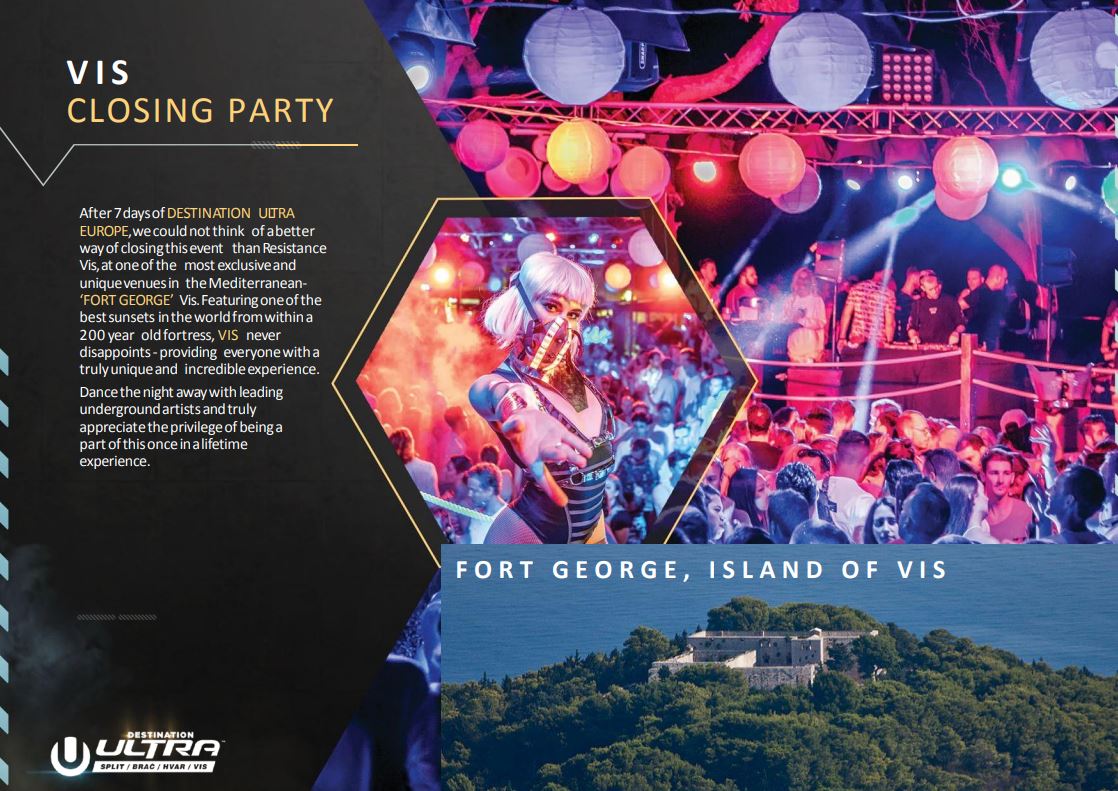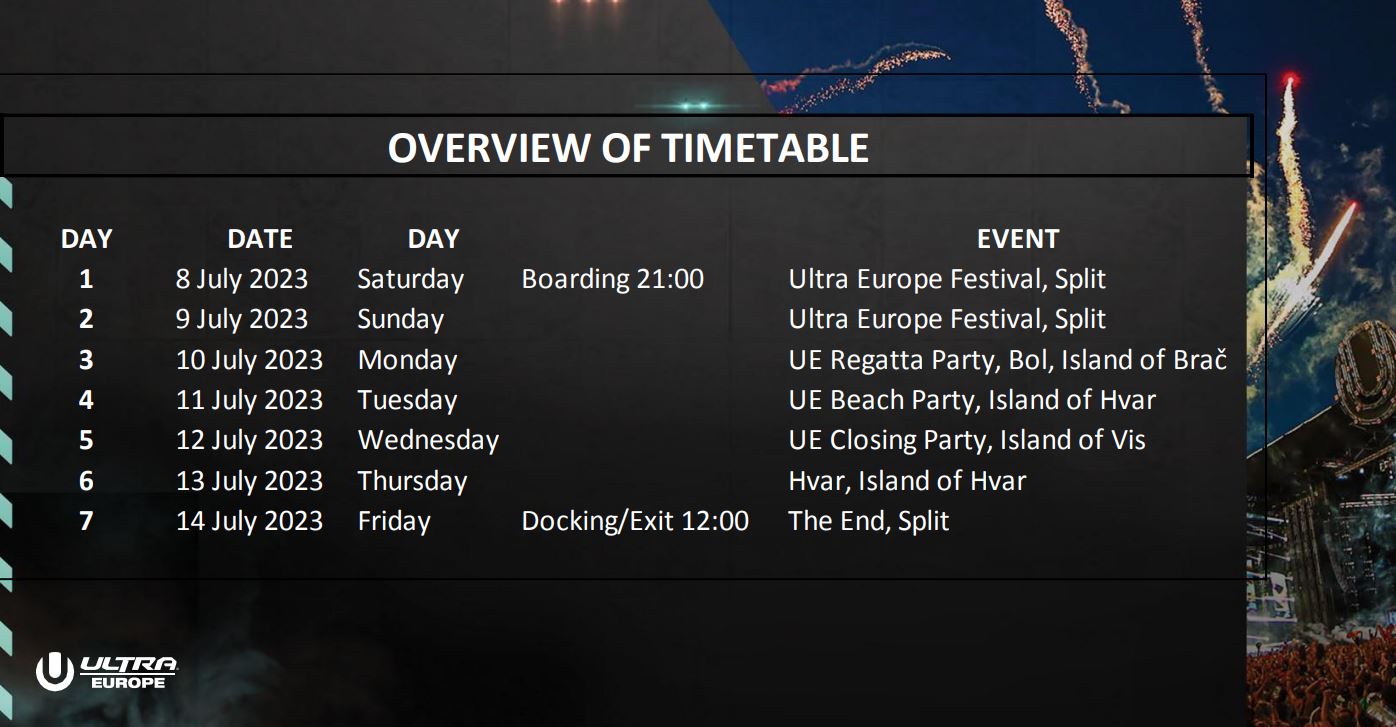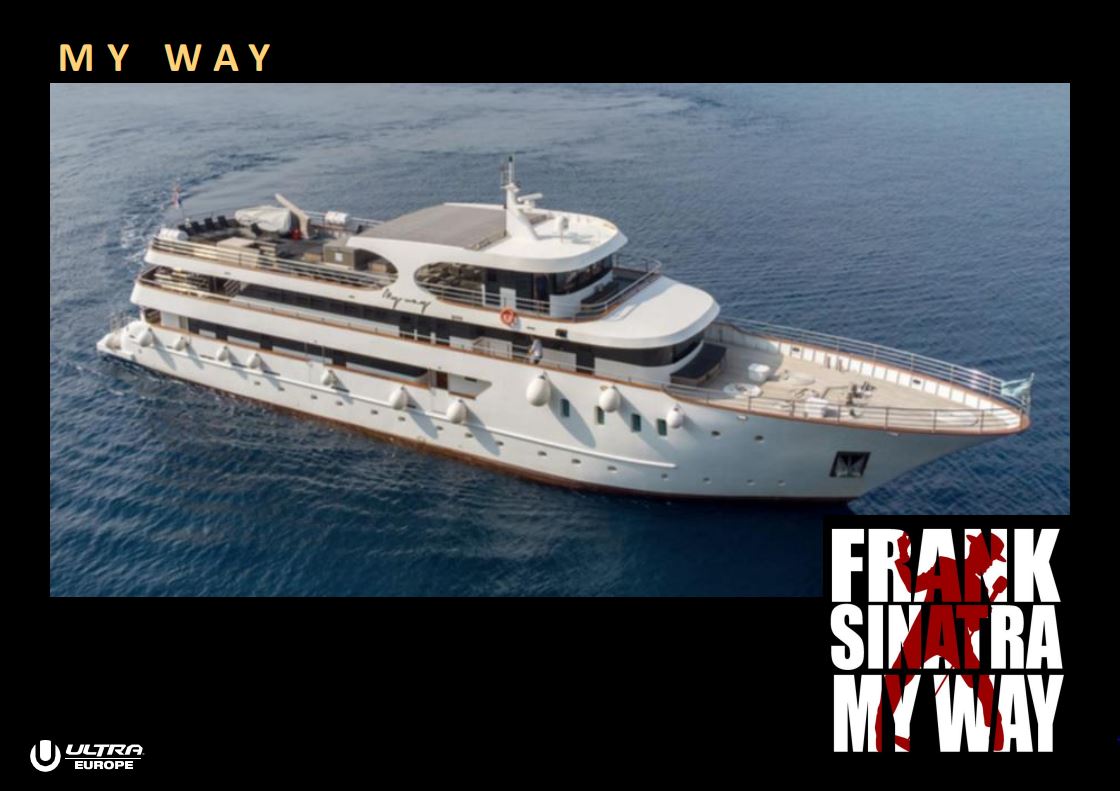Destination Ultra Europe VIP Cruise 2023, Ultimate Yachting Party Experience
February 13, 2023 - Summer is coming, and the Adriatic will be a paradise of sun, sea, festivals and everlasting memories. Combine them all with the ultimate party and cruising experience - the Ultra Europe VIP Cruise. But hurry, there is VERY limited availability.
It is a decade since the festival scene changed completely in Dalmatia with the arrival of the Ultra Europe Music Festival, the largest festival in the Adriatic Region which has been a magnet for tourism in Split over the 8 editions so far. Its initial home at the Poljud Stadium for the main event in Split was followed by a beach party in the cascading pools of Hotel Amfora on Hvar.
Over the years, Ultra Europe has evolved, and its impact on the city of Split has been immense. Last year alone, the festival welcomed more than 160,000 Ultranauts from an impressive 141 countries. The main event is still held in Split, albeit in a new location - – Park Mladež (Youth Park) which has a larger capacity to prior venue. The concept after Split is changing to include more intimate parties at prime locations in top spots on the islands of Brac, Hvar, and Vis.
And while the majority of Ultranauts are regular festival goers, over the years, Ultra Europe Festival has developed a very attractive VIP offer, which attracts plenty of higher spending guests looking for that something extra, and one can see a marked increase in private planes at Split Airport in the days of the July festival. Indeed, in a recent interview with TCN, Ultra Europe Music founder Joe Basic explained that the average spend of an international Ultranaut was in the region of 3000 EUR.
But for those looking for a little extra...
What better way to enjoy a holiday on the Adriatic as an electronic music lover than a VIP cruise which takes in all the parties by yacht between the Dalmatian capital of Split to the follow-on parties of three of Dalmatia's premier islands of Brac, Hvar and Vis?
The Ultra Europe VIP Cruise is a unique opportunity to enjoy the Ultra experience from a viewpoint of luxury, comfort, hospitality and fabulous views as you cruise around the Adriatic, recovering from the previous night's partying, while preparing for the long night ahead.
The 7-day journey takes in the four festival locations of Split, the regatta party by Zlatni Rat at Club 585 on Brac, Carpe Diem Beach on the Pakleni Islands off Hvar, and historic Fort George on Vis, as well as an extra day on the island of Hvar, Croatia's sunniest island.
There will be three boats in the Ultra Europe VIP Cruise offer, and as you can see from what is included below, the only thing to worry about is what cocktail to start the party with. The first two boats are already sold out, and there is now limited availability on the third, a lovely vessel called My Way.
The 150-foot yacht, complete with jacuzzi, sun deck, restaurant, salon and air-conditioned cabins, is the perfect way to relax and island hop. With 19 double cabins and one single, the maximum number of guests for this unforgettable week is just 39.
And the benefits don't end there... The Ultra Family VIP Package is also included.
There are many ways to experience the magic of the Adriatic, and there are options to suit all budgets. But as COVID-19 is hopefully a distant memory this summer, there can be few better options to combine festivals, parties, and the magic of Dalmatia's premier islands than the Ultra Europe VIP cruise.
Reserve now with payment of €2.400/person, 2 people per cabin, for a total of 4.800€. This early bird price is until the end of February, after which the price will rise to €6.000€/cabin. Do not miss out the Ultra Vip Cruise which includes yachting on the Adriatic sea under the sun and partying all night with VIP Family access to all Ultra Europe Events making this the experience of a lifetime.
For more information, and to book, contact This email address is being protected from spambots. You need JavaScript enabled to view it.
And I leave you with a reminder of the 2022 Ultra Europe Festival experience, with the 2022 aftermovie, below.
Montenegrin Admiral Vladimir Barovic Gets Memorial Plaque on Vis
September the 16th, 2022 - Montenegrin Admiral Vladimir Barovic has had a memorial plaque dedicated to him on the island of Vis. The admiral famously refused to take aim at or do any harm to Dalmatia, taking his own life instead.
As Morski writes, a memorial plaque to Montenegrin Admiral Vladimir Barovic was unveiled in Samogor on the island of Vis this past week. The unveiling of the memorial plaque was attended by the Ministers of Foreign Affairs of both Croatia and neighbouring Montenegro, Gordan Grlic Radman and Ranko Krivokapic, the Ministers of Defense of the two countries, Mario Banozic and Rasko Konjevic, and the Mayor of Vis, Ivo Radica.
In his address, Minister Gordan Grlic Radman emphasised the importance of nurturing the culture of memory, noting that the installation of the memorial plaque on Vis is a continuation of last year's commemoration of the suffering of Croatian nationals imprisoned in the infamous Morinj camp.
"Vladimir Barovic's act of humanity and his show of staunch disagreement with evil is a symbol of those values that today, just as they were thirty years ago, are a pledge of relations based on mutual respect. He was deeply aware that the army of which he was the commander wouldn't be the one he could serve honourably, because its intentions were dishonourable, occupational in their nature, not to mention criminal. That September, he fired only one bullet and that was unfortunately the only possible way he could get out of the hellish plan of aggression of the Yugoslav People's Army (JNA) against the Republic of Croatia," he stated.
''His words written on the plaque that we've unveiled open up many questions within us, and they question the fundamental principles that we should all cherish towards each other, nation to nation, human to human. We feel the obligation and duty right here on the island of Vis to set up a memorial plaque to him as a thank you to him and as a memory, but also to showcase the fact that even during the most difficult times dominated by war, one man put his honour before his command and proved he'd sooner take his own life than destroy Dalmatian cities and the Croatian people,'' added Minister Grlic Radman of Montenegrin Admiral Vladimir Barovic's actions.
He concluded the presentation by pointing out that the Republic of Croatia and Montenegro will continue to work on and strengthen their good-neighbourly relations and work on open issues they both have, and that Montenegro will continue to enjoy the firm and friendly hand of support of Croatia on its European Union path.
Minister of Defense Mario Banozic also pointed out that after more than three decades, we now have the opportunity to mark a moment in history that is important for all of us.
''The act carried out by Admiral Barovic represented a big step in the relations between our countries, as well as in the relations between the navies of the Republic of Croatia and of Montenegro, which, through cooperation in the field of education at the Dr. Franjo Tudjman Croatian Military Academy, they learn and strengthen themselves not with the aim of war, but with the aim of deterrence. This was also done by Admiral Barovic, thanks to whom the ugly scenes that people in other parts of Croatia experienced during the Homeland War were averted in the area of Vis,'' Banozic pointed out, adding that with this memorial plaque, we convey to future generations what Admiral Barovic and his actions meant to Croatia.
For more, make sure to check out our dedicated lifestyle section.
Blue World Vis Gets Financial Support for Educational Point Installation
September the 15th, 2022 - The Blue World Vis (Plavi svijet Vis) organisation has received a large sum of money for the carrying out of their educational checkpoint project on this gorgeous Dalmatian island.
As Morski writes, Blue World Vis has received financial support in the encouraging amount of almost one million kuna for the implementation of their project "View of the Sea - the educational checkpoints of the island of Vis/Pogled na more - edukativni punktovi otoka Visa''
The purpose of the project is the education and sensitisation of the wider general public on the topics of environmental protection and biodiversity through the creation of three educational checkpoints on the island of Vis. The entire operation is being co-financed by the European Union (EU) from the European Maritime and Fisheries Fund.
Raising the public's level of awareness of the dangers of climate change and failing to correctly take care of our environment has become more and more prominent in our society as a whole, and within the European Union, there have been many efforts focused on going green and digital, eliminating our habit of needlessly harming the environment and causing damage to our planet for future generations.
Across Croatia, there have been multiple projects carried out dediated solely to the selfless cause of raising environmental awareness, from regular organised beach and seabed clean ups to the financing of proper waste separation and recycling yards. The Blue World Vis project is just one in a string of such projects set to educate the public about this burning global topic.
For more, make sure to check out our dedicated lifestyle section.
Komiza to Get Brand New 5 Hotel in 52 Million Euro Investment
August the 27th, 2022 - Komiza on the beautiful Dalmatian island of Vis is set to get a brand new five star hotel complex as part of a large 52 million euro investment.
As Poslovni Dnevnik/Marija Crnjak writes, the entry of Marriott's lifestyle brand Autograph into Hotel Bisevo has now been officially signed off. As was announced by the company Modra spilja on the Zagreb Stock Exchange on Thursday, the members of the company's management, following the approval of the general assembly and the supervisory board, have now signed the License Agreement for the Autograph Collection hotel brand, under which the Hotel Bisevo in Komiza on the island of Vis will operate.
As was previously written about, this is part of a huge investment totalling 52 million euros in the construction of a new exclusive hotel in Komiza, in which the company Modra spilja is entering with the majority shareholder, PBZ Croatia osiguranje (insurance) pension funds.
In place of the bulky concrete building of the current two-star Hotel Bisevo, Komiza will be richer for a five-star hotel in the year 2025, which will fully fit into the natural environment provided by Vis, and view of the town, as well as a new promenade by the sea.
The 3LHD architectural studio, the Bruketa&Zinic&Grey agency and the Hotel&Destination Consulting consulting company were all engaged in the realisation of this project alongside the investor.
The Autograph Collection brand otherwise belongs to what is known as the "premium distinctive" group of Marriott hotels, which lies somewhere in the middle between luxury and select hotels, and in terms of content and style, these are unique hotels that emphasise the local culture and history of the locations in which they're constructed, as opposed to dominating the destination and overriding the history of the place.
For more, make sure to check out our dedicated business section.
Massive 52 Million Euro Project to Begin Transformation of Vis Island
June the 10th, 2022 - A massive 52 million euro project is set to begin the transformation of gorgeous Vis island, bringing it up to a far higher level when it comes to tourism.
As Poslovni Dnevnik/Marija Crnjak writes, with a huge investment of 52 million euros in the construction of a new exclusive hotel in Komiza and bringing Marriott's lifestyle brand Autograph Collection to the Republic of Croatia for the veru first time, the company Modra spilja (with the majority shareholder being PFZ Croatia osiguranje) will initiate the transformation of Vis island.
On the site of the bulky concrete building of the current two-star Hotel Bisevo, Komiza will get a five-star hotel that will fit entirely into the surrounding natural environment and the view of the city, and a promenade by the sea which will soon be walked along by some new guests, the users of Marriott's loyalty club.
In addition to the investor, the architectural studio 3LHD, the Bruketa & Zinic & Gray agency and the company Hotel & Destination Consulting have all been engaged in the realisation of this project, which has been underway for the last year now.
"Our goal on Vis island is to develop a high value-added tourism product, with a globally recognisable hotel brand that guarantees standards recognised around the world, in order to better capitalide on this remote and unique destination. We simply want to take advantage of the distance and harder accessibility of this destination which is ideal for an escape from reality, for wellbeing, and for the recovery of both body and mind from hectic lifestyles.
Autograph is ideal for such a product, because it's a brand in which each hotel is different, it has its own special story that is usually related to local culture or traditions, and the content is related to that,'' explained Mario Radakovic, a member management of the company Modra spilja.
As it is known, the pension fund PBZ CO paid its creditors back in 2019 and ended the bankruptcy proceedings of Modra spilja, after which the company was listed on the Zagreb Stock Exchange, and there was a recapitalisation to maintain liquidity during the coronavirus pandemic and to prepare investments.
Marriott is currently in the process of licensing the Autograph Collection brand, concluding a financial structure with both creditors and investors, and amending the urban development plan for the Komiza settlement (UPU) so that all permits can be obtained.
The preliminary design bears the signature of the Zagreb-based company 3LHD, which presented it to the local community about 10 or so days ago. A completely different concept of hotel will now be built, with almost the same number of rooms, but with a significantly reduced environmental impact and total visibility from the sea.
HDC was in charge of designing the concept, the market positioning, the content and the financial projection of the project, while Bruketa & Zinic & Gray will be in charge of branding and designing the central theme of the hotel.
It's worth noting that the Autograph Collection brand belongs to the so-called "premium distinctive" group of Marriott hotels, which is in the middle in terms of luxury (between luxury and select hotels), and in terms of content and style, they are unique hotels that emphasise local culture and traditions. Under the Autograph Collection brand, there are about a hundred hotels on five continents, most of them in Europe, Central America and down in the Caribbean.
It's already known that a very important segment in the up and coming Komiza hotel will be wellness, which will recreate the famous Blue Cave attraction on the island of Bisevo, with a number of indoor and outdoor pools and facilities surrounded by a rich Mediterranean garden, which is another important component of the project. Otherwise, the hotel will consist of several smaller buildings connected by corridors.
It will reinterpret the urbanism of the town with courtyards in a modern way, and Zagreb's 3LHD has placed all of the infrastructure underground, including the garage. The hotel will have a total of 133 accommodation units. An additional 28 residences are planned to be cascaded above the road and be naturally connected to the existing facilities in Komiza. With several outdoor pools, a large infinity pool with a roof top bar right next to the promenade by the sea, some rooms will have private pools, and the turnkey investment will stand at an enormous 320 thousand euros.
In addition to all of the above in the transformation of Vis island, this large project will be maximally "green", in accordance with the possibilities of this remote location, so that a good part of local materials will be built into it, and solutions will be sought that will be sustainable in the future maintenance of all of the facilities. Radakovic emphasised the great importance of existing good infrastructure on Vis island and the intentions of local authorities to further improve it.
“As a volcanic island, Vis has its own water sources, which is very important for the sustainability of the project, as well as the largest island solar power plant in the entire Adriatic. For our guests, we plan transfers from Split Airport as well as the re-establishment of sea routes to Italy, which will be interesting for the future development of tourism on the island,'' said Radakovic.
The closure of the entire construction of this huge future investment should be completed in the next six months. That in itself is a prerequisite for the start of construction, which could begin in the spring or autumn of 2023, and it is planned to last for 18 to 24 months. Objectively, the new Autograph Collection Vis could be on the market for the 2025 summer tourist season, the investor predicts.
For more, make sure to check out our dedicated business section.
Meet NK Vis, the Most Isolated Football Club in Croatia
April 6, 2022 - Meet NK Vis, a football club and school fighting for the island's youth, allowing no distance to deprive its children of playing the sport.
Football is played around the world thanks to its simplicity - even in the most isolated places. Because Croatia is a small country, almost no one thinks of really isolated places, but if you sit on the ferry from Split to Vis, you'll need to kill two hundred minutes of sailing to one of the most beautiful Adriatic islands. When Brač and Hvar are behind you, in the distance rises Vis, surrounded by sea-strewn cliffs, and right there on the high seas, there is a small club of the same name that has been resisting its geographical integrity for decades, writes Aldo Franičević for RTL.hr.
Football on the island has a long tradition, and NK Vis celebrated its first days back in 1935, but Vis had to replace the football with rifles due to World War II. At the end of the great war, NK Naprijed Vis was launched, which existed for three and a half decades. Interestingly, HNK Hajduk even played a friendly match against the Vis club.
Unfortunately, its isolation and lack of money left Vis without a football club in 1979, leaving only the summer indoor league on the island. Soon the island was left without a football field. In those years, it seemed like football had lost the battle with distance after decades, but in 2006 a miracle happened.
At the end of 2006, Marinko Ivanišević-Mane, with a handful of football enthusiasts, started a children's football school on Vis and registered the Vis football club, thus renewing the continuity of the Vis football school after a 30-year hiatus. A few years later, Vis inhabitants first got a smaller football field, and in 2013, a large grass field was built with the help of the City.
The following year, they registered a senior team that competed in the 2nd County League for several seasons. Unfortunately, the senior team was short-lived, but the football school has survived and is stronger than ever under its young and ambitious leader Mario Potočnjak.
Potočnjak spoke about the success of the Vis football school but also revealed the many problems young footballers encounter living on the island.
"Before I came to the club, several coaches changed. In the beginning, there was enthusiasm, and then there was a senior team, but as time went on, interest and opportunities decreased as far as the senior team was concerned. They competed for a while, but they stopped before I came. After that, they played in the county league, but now they don't play anymore. However, the football school is still alive, and I can say that it has grown nicely," said Mario Potočnjak, a 28-year-old coach from Pag who has been leading the development of the sport on Vis for five years.
Although the senior team shut down some time ago, the football school is growing and thriving thanks to the efforts of coaches and the encouragement and support of the local community.
"This year, we have 70-80 students. Of course, that number varies, especially in the winter. We also work with preschoolers, which are children aged 5-6. We currently have four categories - 10-12 preschoolers, some boys, some girls, about 15 younger beginners made up of first graders, there are about twenty beginners and a group of younger pioneers competing this year in the 3rd County League, and there are just over 20 of them. These are mostly children from Vis and Komiža, with a few children from the surrounding areas. It should be said that these 80 boys and girls are quite a number considering the total number of children in the island's primary schools," says Potočnjak, adding that clubs on the islands face problems that they can hardly imagine on the mainland.
The biggest problem is the poor connection with the mainland and other islands, which is always a full-day trip, even when traveling to nearby Hvar or Brač.
"The worst thing is that when we play on land, we have to take the ferry at 5:30 in the morning from Vis, which means the kids have to wake up around 4 am. This is especially problematic in the winter, and it is in the winter that we cannot rely on a catamaran that should leave at 7 am from Vis because you never know what the weather will be like and whether it will run. The trip by ferry to Split lasts for over two hours, and the matches are played at 9 am. This is a big problem when it comes to performance on the pitch, but the worst thing is that it is very hard for children and takes a long time," reveals the head of NK Vis.
"It's still good when we play in Split because when we play in other places, it is even more problematic. For example, against clubs from Hvar, Brač. We are fighting a battle with the Federation and trying to explain to them that in this league of young pioneers, in which there are only seven clubs, we have the biggest problem when we go from island to island. Of the seven clubs, two are from Brač, Jelsa from Hvar, and we are from Vis. Those from the Federation think we are close to the islands, so it is easy. It is easier for us to go to Sinj or Imotski than from Vis to Brač and Hvar in winter," says Potočnjak and immediately explains.
"When the weather is bad in winter, we would have to go from Vis to Split and then again an hour and a half back to Stari Grad on Hvar, arrange transportation to Jelsa and then repeat it all on the way back for an hour-long game. So when we have those games in the winter calendar, we somehow agree to move it to spring and then organize a speedboat or transport. In the end, it turns out ok, but it requires a lot of organization and money," Potočnjak added and gave an example from the 14-hour visit to NK Postira Sardi on Brač.
"They couldn't play that game on Saturday because other categories were playing for them then, and we decided not to forfeit and change it for a later date. So on Sunday, we leave Vis a little later, around 7:30. But the problem is with the return. The first boat to Vis that we can get is only at 7 pm. We were in Split by 3 pm, but we could only go home four hours later. We came to Vis around 9:30 pm. In other words, we spent about 15 hours going from Vis to Brač just to play an hour-long game, and the children go to school on Monday. That's a huge amount of energy spent that way," Potočnjak adds.
But as he says, giving up is not an option, and everyone is looking at how to make this positive. What saddens him is that his teams often fail to show their best performance when playing away, considering that they are exhausted even before they put on their jerseys and run on the pitch.
"I noticed a big difference in the quality of performance. We have a small base, and the difference is felt when you play against clubs from Split, but regardless of when they come to visit us, the game will be at 2 pm because they come by ferry from Split at 11 am. The visiting teams on Vis don't have that problem. There is a big difference in the energy of our children when we play at home and away, so the result suffers a little, but in principle, the result is not primary," Potočnjak said.
He is happy that the local community is actively involved in the club. Namely, a lot is being invested in sports and youth in the City of Vis, and even apartments for young families are being built, which suggests that the club could soon get more new players.
"NK Vis is almost exclusively financed by the City of Vis, and this is where we encounter small disagreements because many of the boys and girls in the club are from Komiža. Unlike the City of Vis, they have not had an understanding for years, and we have little help from them. This year, they helped organize transportation for children from Komiža, but now new problems have arisen. In addition, we have income from membership fees that amount to a symbolic one hundred kuna per month," reveals Potočnjak and uses the opportunity to highlight the benefits the entire island has from the club.
"The club's contribution to the community is great because, unfortunately, there is no other sports organization on the island in which children can join. There have been some attempts at basketball and the like, but it has not come to life. There is bowling and bocce in Komiža, but without belittling anyone and any sport, it cannot be compared to football. Practically, this is the only thing we have to offer children from systematic activities," claims Potočnjak.
So, what ambitions do the club and the city have in the future?
"There's no plan to re-establish the senior team at the moment. Some guys are more ambitious and would play, but it dies quickly, and the costs and fines are enormous. If the boys don't get together or can't go to the game, the Federation issues fines, and debts are still dragging on from when the senior team existed, so it is better to focus all energy and strength on youth," concluded Mario Potočnjak.
He added that they are all focused on the 14th tournament for Vis City Day, which takes place on April 23 with several football teams.
To read more about sports in Croatia, follow TCN’s dedicated page.
New Hotel in Komiža Will Put Too Much Pressure on Public Infrastructure, Claim Local Residents
March 14th, 2022 - Komiža residents are worried whether the public infrastructure of their town, which covers an area of 48 square kilometres and has a population of 1,500, will be able to withstand the increase in road traffic expected after the new hotel opens for business
Residents of Komiža, a coastal town on Vis island, have been voicing their concerns lately in regards to the announced construction of a new hotel, reportedly twice as big as what the public infrastructure in this little town could withstand.
The first public presentation of the new Hotel Biševo was scheduled for today, but only city councillors and members of the Department of Urbanism and Physical Planning were invited to attend. The residents of Komiža, in turn, haven’t been invited, and they’re rightfully worried that the new hotel with 700 beds is going to put too much pressure on their little town, reports Morski.hr.
The old Hotel Biševo was a two-star facility with 300 beds. A new luxury hotel with double the capacity will be built in its place, further increasing the number of guests in the already popular destination.
The investor was the one who decided that the residents shouldn’t attend the presentation, as stated in the invitation. The hotel is owned by PBZ Croatia Osiguranje, a compulsory pension fund. It’s also known that the project involves the company Modra Špilja d.d. from Komiža, architecture studio 3LHD from Zagreb and the company Urbos d.o.o from Split, with the latter known to deal in physical planning.
Komiža residents have reason to wonder whether the public infrastructure of their town, which covers an area of 48 square kilometres and has a permanent population of 1,500, will be able to withstand the increase in road traffic expected after the hotel is put into operation. The citizens are not against the hotel, but they’re calling for a facility of appropriate size and capacity for a place like Komiža.
Concerned councillors and citizens have addressed the competent ministries on several occasions, most often in regards to the legality of the process and the decision not to involve the citizens in the process of modification of zoning plans, but have not yet received proper answers.
‘The public will be involved once a public consultation is announced’, stated Komiža Mayor Tonka Ivčević in a short reply to the latest inquiry from Morski. Although it’s been nearly a month since they’ve sent her a detailed query regarding the project, the mayor has only replied with the above statement this morning, after they pointed out that ignoring reporters won’t help her turn the public’s attention away from the matter.
Mayor Ivčević has reiterated that ‘the interest of Komiža locals is her top priority’ and that ‘she would never allow for anyone to disrupt the development of Komiža for the benefit of its residents in any way’.
Many guests and returnees are worried for the future of Komiža, as they’ve chosen to live or stay in this town exactly because it’s quiet, peaceful and pleasant to reside in. The question is, how long is it going to remain that way?
‘Besides, the Food Is Very Good’: Impressions of Croatia in Travel Journals of Yore (II)
February 5, 2022 - In the second part of the feature exploring impressions of Croatia found in old travel journals, we're retracing the steps of several foreign visitors in Dalmatia.
If you haven't read the first part, please head here to meet our protagonists, fearless adventurers and diligent reviewers, and see what they thought of Istria. We’re picking up where we left off, with all of our esteemed travellers heading further south.
First up, Zadar, the main Venetian base on the Croatian coast back in the day and thus an obligatory stop on every tour of the Adriatic. Very well defined in this succinct statement by archaeologist Jacob Spon who travelled in Dalmatia in 1675:
It’s the capital and one of the best places that the Republic owns in Dalmatia.
He also liked the cathedral and excellent paintings of Titian and Palma displayed in the churches of Zadar, but I’ll spare you the rest of the paragraph as it’s not more than a list of artworks.
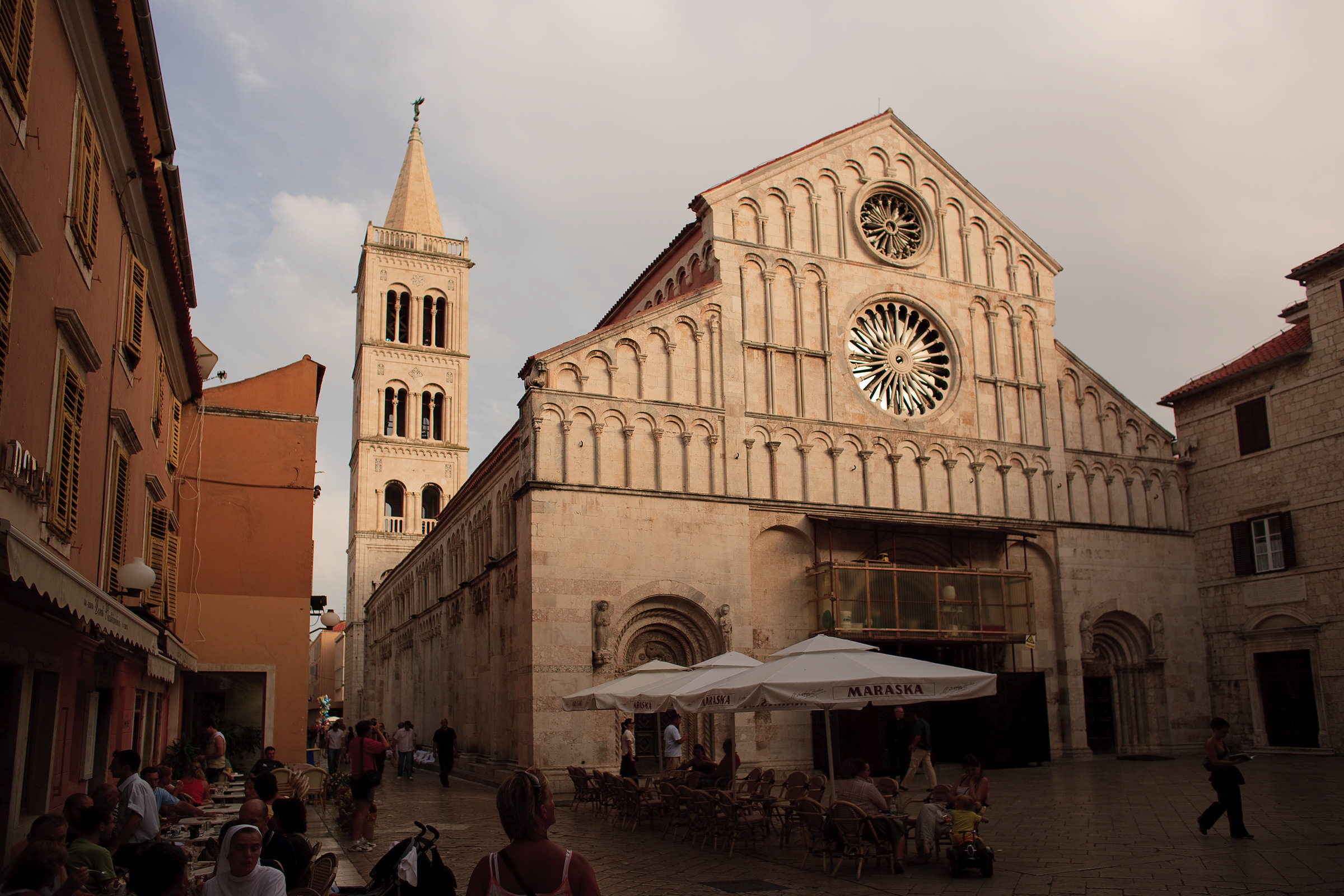 Zadar cathedral by Romulic
Zadar cathedral by Romulic
A few thoughts on Zadar by Noé Bianchi who visited in the 1770s, in his trademark enumeration style:
The city has six gates, a great Arsenal, and many ships and boats. It is a beautiful port, and a place to live in abundance; its territory spans over thirty miles on the mainland, with many castles, islands, and more than four hundred reefs. There are large pastures with plenty of livestock, and an abundance of all sorts of fish; they dress pompously, are very devoted to arms, but above all to humanist studies; they have many schoolmasters, and a lot of merchants.
Let’s hope it was the people of Zadar who dressed pompously and not the fish. Thankfully, we have a new character in our story: countess de La Morinière de La Rochecantin who offers her view of the locals, having visited Zadar in 1907:
The men are not handsome at all; their eyes are hard, their facial features sharp. The women, on the other hand, have a beautiful smile and something seductive under those colourful scarves with which they cover their heads.
Sorry, men of Zadar.
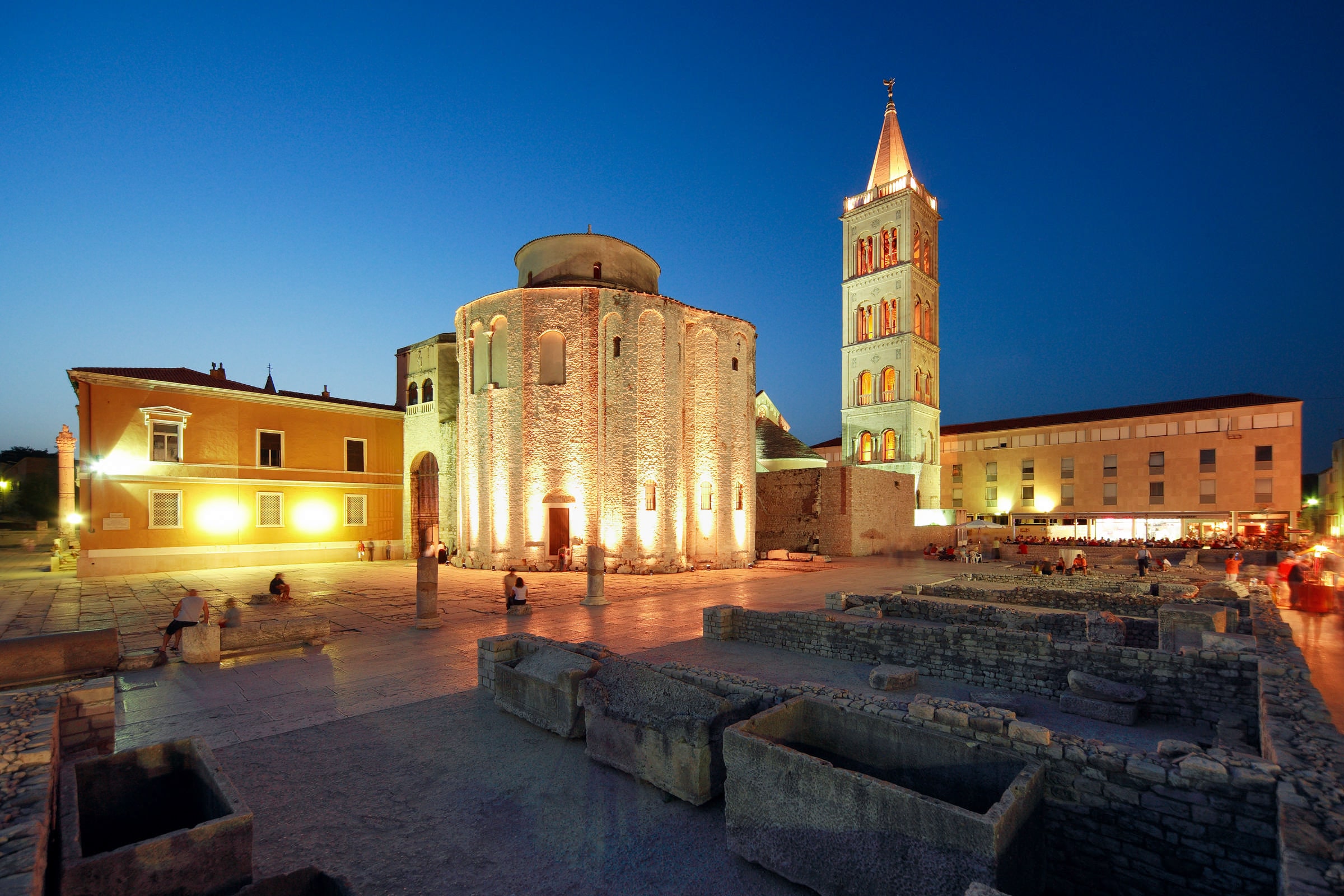 Zadar by Romulic
Zadar by Romulic
***
On we go to Trogir, where the countess notes the following:
The inhabitants are largely similar to those of the Illyrian islands, but this lot is more gentle. They live here in a small Provence. Tamarisk trees and pines, through which a soft wind whistles as if in song, line the narrow paths that run along the shore.
This morning, the water glistens with opal reflections, the air is gentle and warm, but it’s enough for the sky to get veiled in clouds for a feeling of melancholy to take hold of us. In these countries where the sun is king, it alone gives life to beings and things: aromatic plants, trees with pale foliage; the flora of such ardent regions only comes alive and reveals all its splendour and perfumes in the light and under the scorch of the sparkling star.
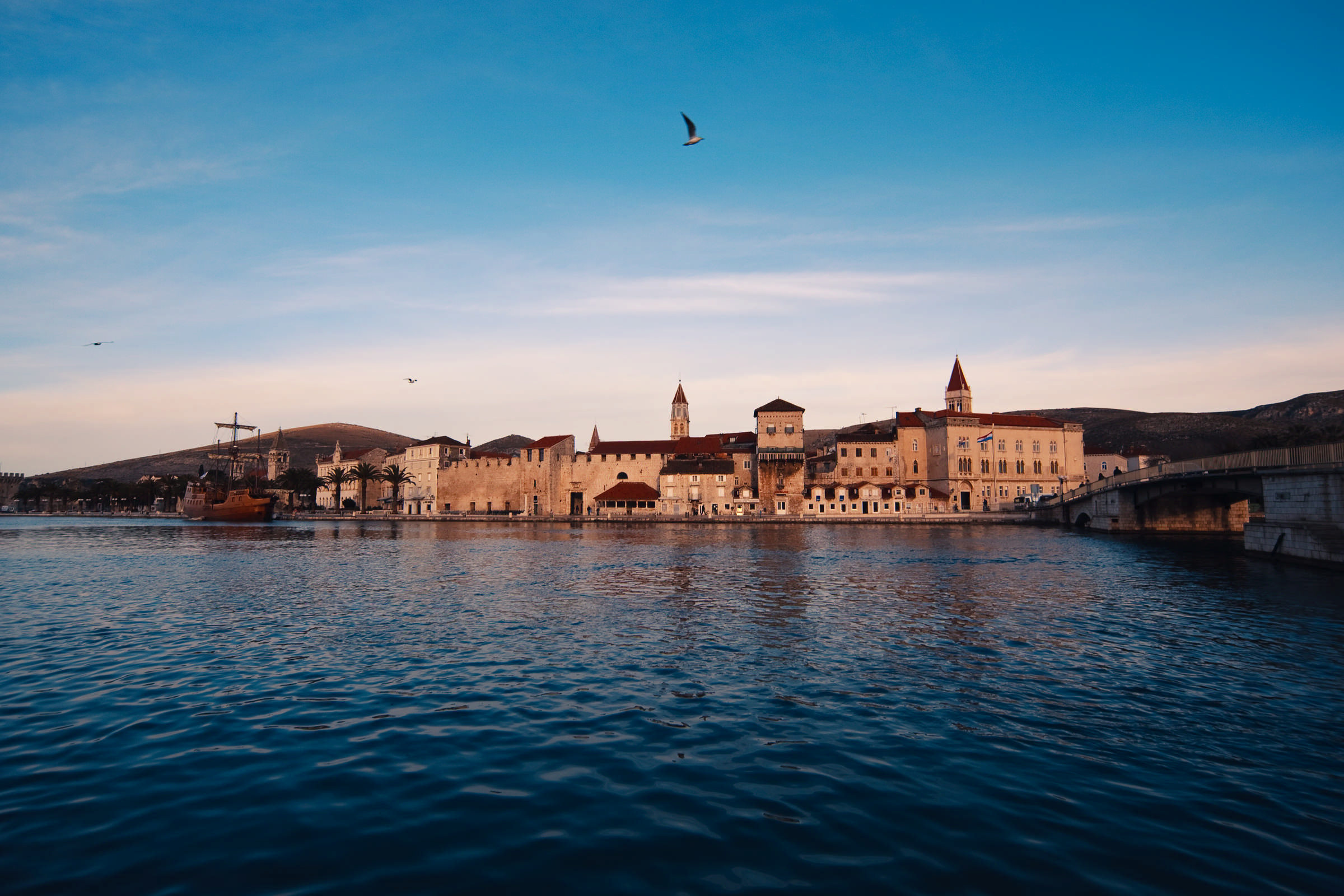 Trogir by Mario Romulic
Trogir by Mario Romulic
Spon on the other hand has a less poetic approach and seems to be excited about Trogir mostly due to it being the birthplace of Ivan Lučić Lucius, a Croatian historian of international renown.
Lucius is known as the father of Croatian historiography owing to his work 'On the Kingdom of Dalmatia and Croatia', in which he gives a comprehensive account of Dalmatia’s history from the Roman times to the end of the 15th century. Seemingly enough to merit admiration from monsieur Spon who, as we’ve learned, wasn’t easily impressed:
This monsieur Lucius is a nobleman from this country whom I had the honour to meet in Rome, where he is now residing. His homeland is indebted to him for having pulled it from the shadows of antiquity with the historic account he made.
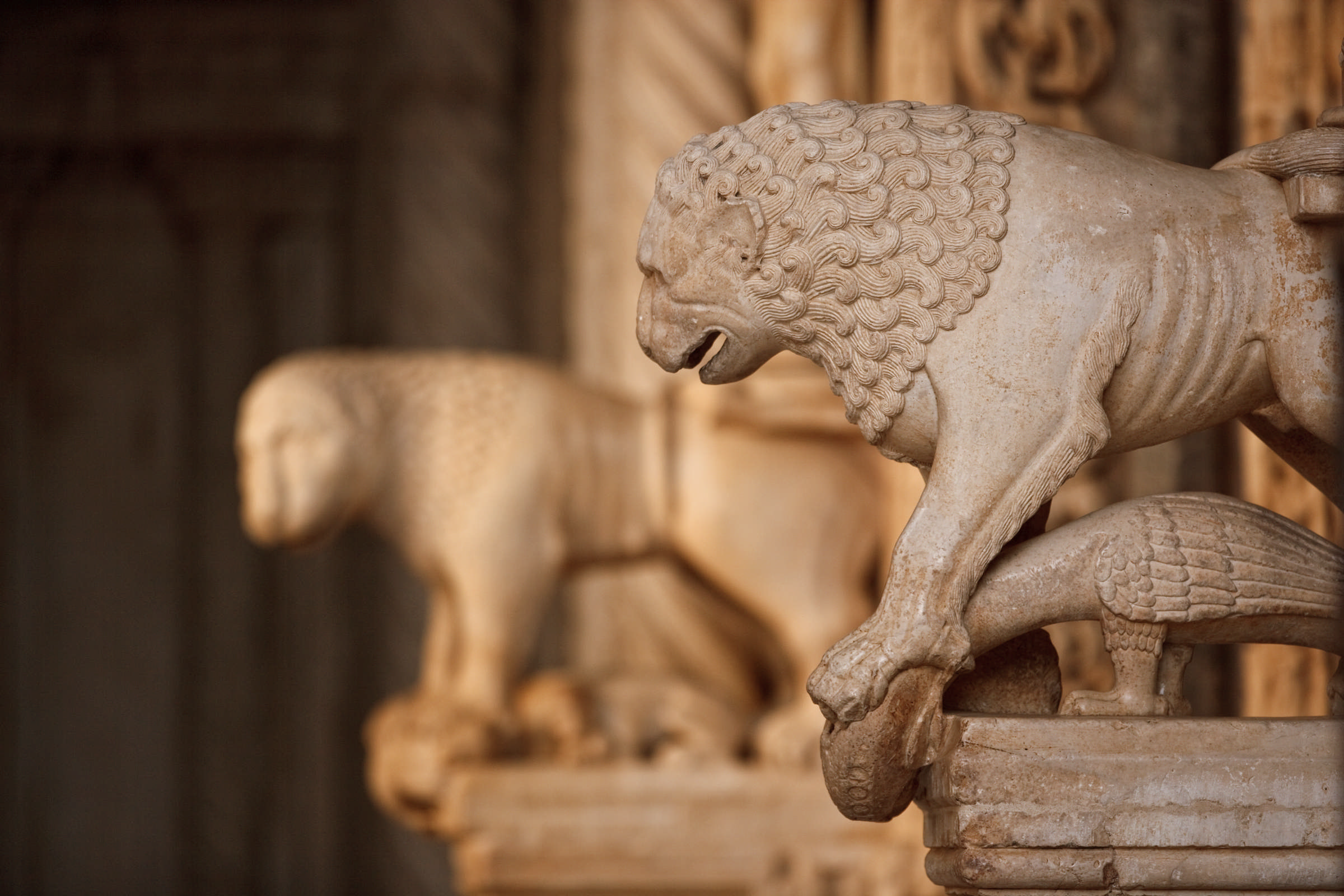 Trogir by Mario Romulic
Trogir by Mario Romulic
Immediately upon arrival, Spon and his party are struck by one of the worst troubles that can happen on a trip: no place to stay!
We had arrived in Trogir at dinner time and were looking for lodging, when we were told that we had to make our own arrangements for dinner, and that it wasn’t customary in that land to deal in hospitality [accommodation].
Naturally, as they were starving at that point, they weren’t exactly happy to hear this, but they got lucky shortly thereafter and found a place in town that sold wine. They were soon ushered into a nearby building that turned out to be none other than Lucius’s palace. This one:
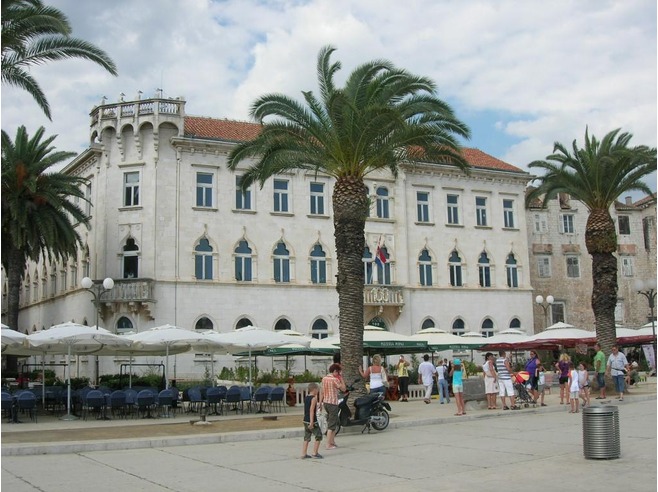
We were surprised to see this house, which is quite beautiful and has a view of the sea, empty and as if deserted, and we were even more surprised when we were told it was the house of this monsieur Lucius whom I just talked about. It has been more than twenty five years since he left it, all because of the incivility of a General of Dalmatia who, having arrived in Trogir, let [Lucius] know he wanted to lodge in his house. The nobleman was getting ready to receive him, and left for himself only a mediocre apartment. But the general immediately sent his people to take all the furniture outside. This impudence annoyed [Lucius] so much, he left the country immediately and never wanted to return.
Loving the gossip. Any thoughts on the sights, though?
The cathedral isn’t ugly. There are some statues in the church, made by a fairly good hand.
Today, the historic centre of Trogir, including the cathedral of St Lawrence, is a UNESCO World Heritage Site.
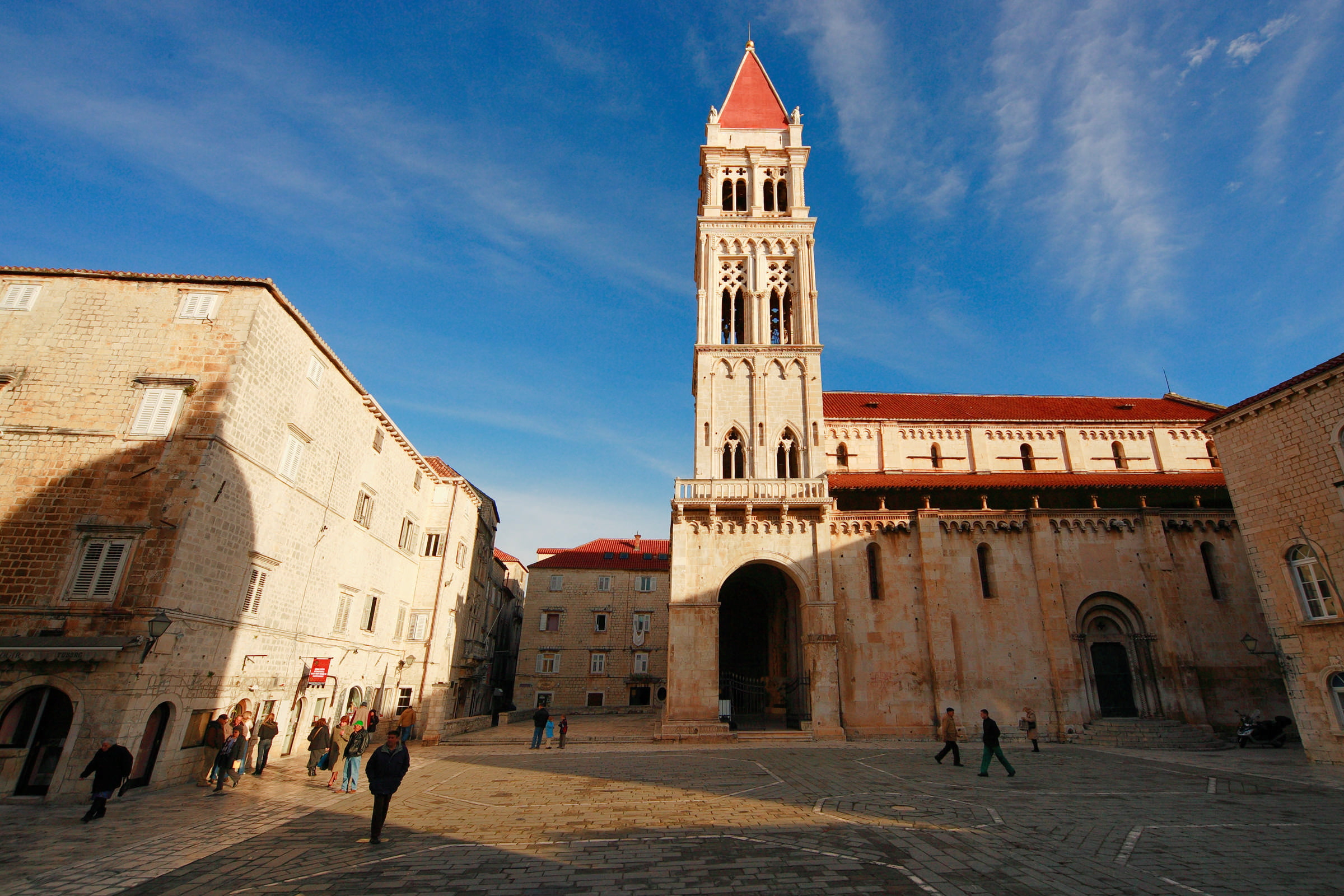 Trogir by Mario Romulic
Trogir by Mario Romulic
We have another appearance by Alberto Fortis who shares a warning: don’t get scammed on your travels! After two pages of musings on marble and its various properties, he says:
As I searched in vain around Trogir to find the famed marble, someone showed up who wanted to abuse my lack of guile by presenting me with a piece of Carrara marble as if it were taken from the nearby hill of St Elijah, where you can find old quarries whose marble isn’t rough at all, but is still far from the refined marble of Carrara.
No one's taking Fortis for a fool!
A traveller must always keep their guard up, as I have, before they draw conclusions based on other people’s claims. I.e., they should go directly to the site in question or at least threaten to do so in spite of all difficulties; that is how you uncover lies.
A marble-related crisis isn’t a situation a lot of us are likely to find ourselves in these days, but fine advice nonetheless.
 The portal of Trogir cathedral by Mario Romulic
The portal of Trogir cathedral by Mario Romulic
He adds a few favourable impressions of Čiovo island:
The island’s climate is truly very pleasant, the air perfect, oil, grapes and fruit excellent, the sea rich in fish, the port spacious and shielded. And its surface isn’t so small that a nobleman couldn’t comfortably walk or ride around it.
Good to know.
***
Before we go on to Split, a note on the hinterland by Marcotti, an Italian writer visiting in the late 1890s:
Those who want to be more in control of their time while travelling in the Dalmatian hinterland will prefer to travel by horse, but will have to get accustomed to a common lack of comfort in regards to accommodation and food: pecorino cheese, stale bread; plum brandy to drink. Corn polenta, ham, roasted lamb, smoked mutton and wine are items of luxury.
***
I believe we’re all familiar enough with the splendour of the Diocletian’s palace in Split to skip the lengthy elegies about its magnificence. Instead, let’s see a few impressions of the town in general, starting with Marcotti:
The market is especially crowded on Monday and Thursday mornings. It is interesting to see how peasants and people from the outskirts of town are dressed: bright colours (blue, red and black), large pieces of jewellery, filigree, gold and silver buttons, chains, medals. Compared with the Morlach women, the women of Kaštela stand out with their elegance.
The countess gets philosophical:
A rosy and curly child, with a serious expression of a grown man, leads us through narrow streets in the ruins of the palace. There is something moving about this loyalty that leads men to live where their ancestors lived, be it within the crumbling walls of an ancient palace or next to a dormant crater that will sooner or later sow devastation and death around it.
![]()
And Spon was surprisingly won over by Split, having spent ten days not doing much other than sampling the local cuisine:
The time we spent in Split did not last us long, because we discovered something new every day and besides, the food was very good. The only downside was accommodation which was not very convenient, as we found but four bare walls.
Partridge only costs five sols there, and hare doesn’t cost much more. There is meat at the butcher’s for one sol a pound, and turtles the size of two fists for four or five sols. But more often than not we preferred to abstain from meat and eat those little trouts from Salona, of which Emperor Diocletian was so fond, that for fear of running out of them he had an express conduit made which brought them to his palace.
 Split by Mario Romulic
Split by Mario Romulic
All of our brave travellers then went to see Klis. Marcotti offers some practical information:
From Split via Klis (2 hours) to Sinj (5 hours), superb road, but the postal service only operates twice a week. A permit from the commander’s office in Split is needed to visit the Klis fortress; it is not granted to ladies.
Rude.
It would take long to recall the whole of its glorious military history, he says about the fortress, then recalls it anyway. A history lesson later, he goes on to say:
The road, the gates, the barracks, they’re all modern; but the walls, the towers, the ramparts, all retain the picturesque charm of ancient military gear: the mosque was transformed into a warehouse. And there’s a beautiful view to boot. In the village, nestled on terraces below the fort, are several taverns.
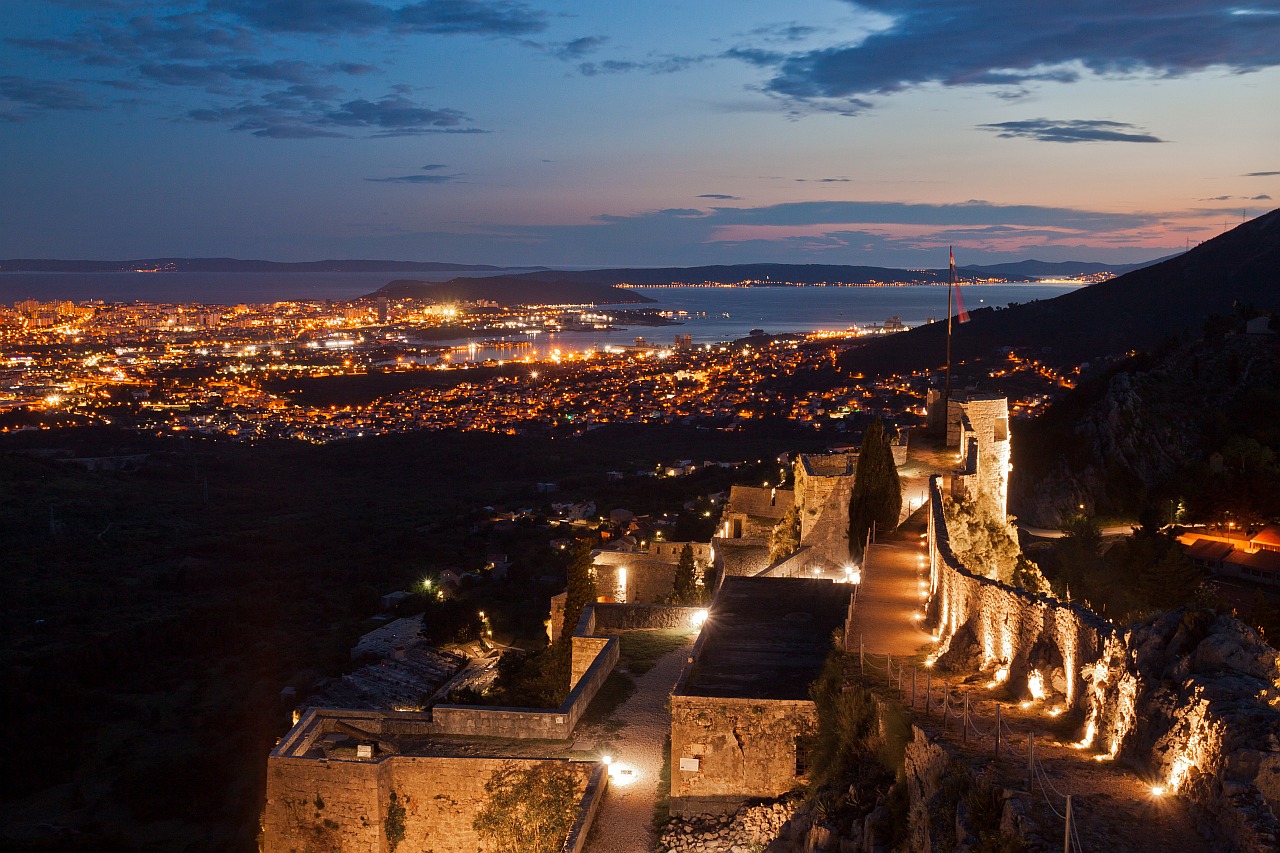 Kliss fortress
Kliss fortress
Countess Rochecantin:
The citadel of Klis, truly an eagle's nest which proudly dominates the valley. The rock it’s built on is surrounded by peaks which would seem inaccessible, if it wasn’t for little pockets of greenery bearing witness to the patient conquest of man over this rugged nature.
And then there’s Spon, bless his heart:
There’s a lack of water and it gets terribly cold in winter. I imagine it’s a harsh penance for a Venetian nobleman to serve here as an officer for two years. 2/10
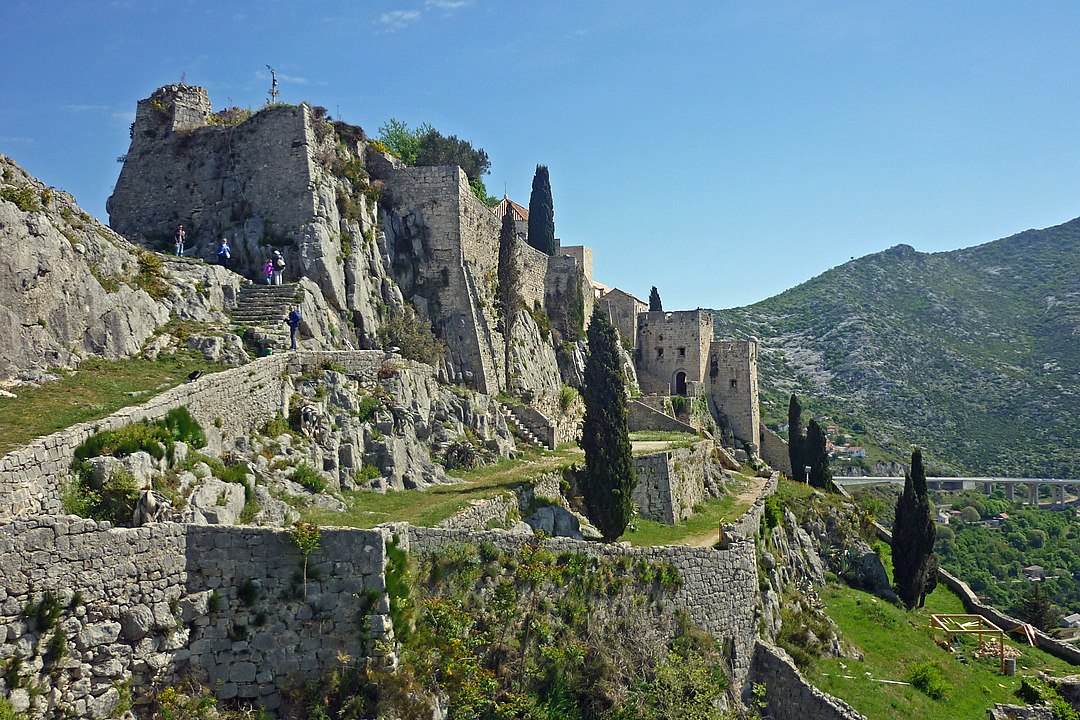 Kliss fortress
Kliss fortress
Marcotti offers a few pointers for towns and islands in the area:
At the mouth of the river Cetina, between Mount Biokovo and the sea is Omiš, a formidable ancient pirate nest. Ruins of the Mirabela and one other castle: excellent wines, pink muscat, even some dessert sparkling wines.
The man truly tells us what we want to know the most.
Šolta isn’t big: its chief town Grohote only has 1200 inhabitants. It’s been renowned for its honey since ancient times; the bees only suckle on rosemary.
Brač is the most important Dalmatian island, in terms of size, population and wealth. They produce vugava, an excellent prošek wine. (...) In the village Pučišće are quarries where stone was sourced for Diocletian’s grand construction in Split.
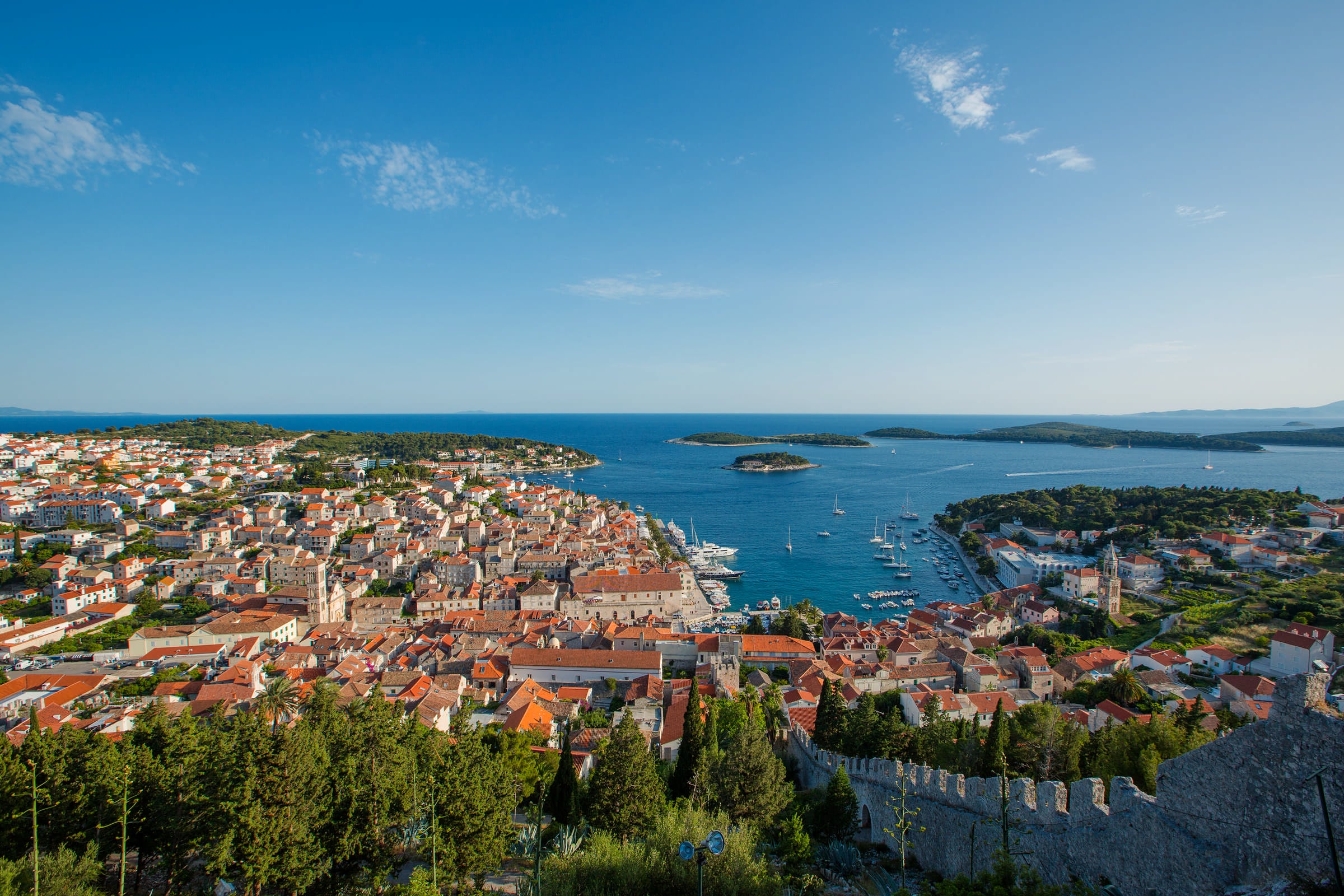 Hvar town by Mario Romulic
Hvar town by Mario Romulic
Hvar: shielded from bura wind by the island’s hills, and from sirocco wind by Pakleni islands, it enjoys a well-deserved reputation as a very favourable climate. Cypress, agave, carob and palm trees thrive there magnificently.
A particular thought stands out in this paragraph. At the time of his visit in the late 19th century, organised tourism was already in development in Croatia, notably in two destinations both mentioned here. Marcotti says:
If direct lines by sea between Italy and Dalmatia were properly established, Hvar town would be a highly recommendable winter destination for the Adriatic regions of the Kingdom, incomparably preferable to Opatija.
According to Spon, Hvar town was an inviting place even two hundred years earlier:
The people of the island, who are three or four thousand in number, have all withdrawn to the town of the same name so they can watch foreigners occasionally dock in their port. So they could receive them with more dignity, they have made there a beautiful pier of marble and stone blocks which lines the semi-circular port.
There is very good bread and very good wine, and plenty of sardines to whet the appetite, with which they also supply Italy and Greece.
 Komiža on Vis island by Mario Romulic
Komiža on Vis island by Mario Romulic
Vis: The island’s vegetation has a distinct southern character, with almond trees, figs, and palm trees. Some excellent wines are the opollo, the Margherita, the prosecco, the gripola, as well as vinegar and brandy. Sardines are abundant in Komiža; anchovies, mackerel, sea bream and snapper are found in all the waters around the island. The suckling lambs are delicious owing to the aromatic pastures of rosemary.
Spon also visited Vis island, but wasn't impressed with the sights:
I won't talk about the fortress, it's just a crow's nest that could be knocked down with ease from the nearby rocks. In the whole garrison there is but one simple soldier who performs the roles of Captain, Sargent and Porter, much like that of Plautus.
He goes to Korčula next, where he learns about jackals:
As this island is covered in woods, it is a haven for several wild beasts. Among them is a certain animal which I am told is built like a dog, but has the cry of a cat or a peacock. If one lights a fire at night near these woods, one can hear a great number of them shrieking and chanting their rabid song, such that those who have never heard them before mistake them for people yelling. It is also said that they dig up the dead to feed on them, and they are good for naught else, but to make some horrid furs out of them.
Next up: Dubrovnik, plus a few places we missed on our way south!
Sources for part II:
Jacob Spon, Voyage de l'Italie, de Dalmatie, de Grece, et du Levant, Fait és années 1675. & 1676., Tome I (Antoine Cellier le fils, Lyon, 1678)
Noé Bianchi, Viaggio da Venezia al S. sepolcro, et al monte Sinai (Remondini, Bassano, 1770)
Giuseppe Marcotti, L’Adriatico Orientale, da Venezia a Corfu (1899)
Alberto Fortis, Viaggio a Dalmazia, 1774 (Croatian edition: Put po Dalmaciji, Globus, Zagreb, 1984)
Comtesse de La Morinière de La Rochecantin, Croisière en Adriatique et en Méditerranée (1907)
Quotes translated from Croatian, Italian and French by the author of the article.
NGO Launches Project for Preservation of Local Fish Species Around Vis
ZAGREB, 12 Dec 2021 - More and more frequently, fishermen on the Croatian island of Vis find in their nets smaller and smaller local fish species and new invasive species, which prompted the local "Pomalo" nongovernmental association to launch a project of raising awareness of the importance of environment protection.
The association, environmentalists, and experts warn that the higher temperature of the Adriatic Sea, the fewer indigenous species. Thus, stocks of small pelagic fish -- sardines, anchovies, or picare -- are dwindling in the eastern Adriatic part, and those fish are important not only for the diet of local inhabitants but also as the fodder of larger fish.
In addition, local fishermen who have first-hand insight into fishing stocks say that for instance, the average size of sardines turns out to be smaller than before. For instance, a kilo of this fish used to encompass about 24 pieces of sardine, while now 40-50 sardines weigh a kilo.
The Komiža-based Pomalo NGO has launched the project called "Neptune's Children" to help local inhabitants, particularly fishermen, to be more successful in dealing with the challenges stemming from climate change.
The association's head Igor Mataić has told Hina that fisheries are one of the rare local business activities that can provide revenues around the year.
The association in cooperation with the Institute of Political Ecology and the Zelena Akcija NGO started implementing the project which includes workshops about climate change and about sustainable fishery management.
Experts also warn that the Adriatic Sea is a semi-closed ecosystem susceptible to climate change, and changes in temperature, salinity, oxygen levels, and sea currents have repercussions for biodiversity.
Professor Branko Dragičević has told Hina that the Adriatic ecosystem can be endangered by new poisonous fish such as silver-cheeked toadfish, red lionfish, and other predatory fish that can also be dangerous for people.
Local fishermen say that when it comes to invasive species they have come across Mediterranean parrotfish, grey triggerfish, African sailfin flying fish, or yellowmouth barracuda.
For more, make sure to check out our dedicated lifestyle section.
Summer in Croatia Through the Lens of Croatian Photographer Timotej Gošev
November 20, 2021 - ''I want people to look at my photographs, and simply desire to be right there in the place their eyes are seeing'', says Timotej Gošev, better known as Timotej on Instagram, inviting thousands of people every day to experience the Adriatic summer through his photographs. Total Croatia News managed to interview the photographer with Varaždin roots.
In what ways can photography positively impact the promotion of tourism in Croatia? The question may sound simple to answer, but nowadays photography can be manipulated in such a way that the first impression of a tourist upon arriving at his destination is one of disappointment. It happens in many parts of the world. The use of visual content, to be used responsibly and strategically, can be essential to make Croatia known around the world.
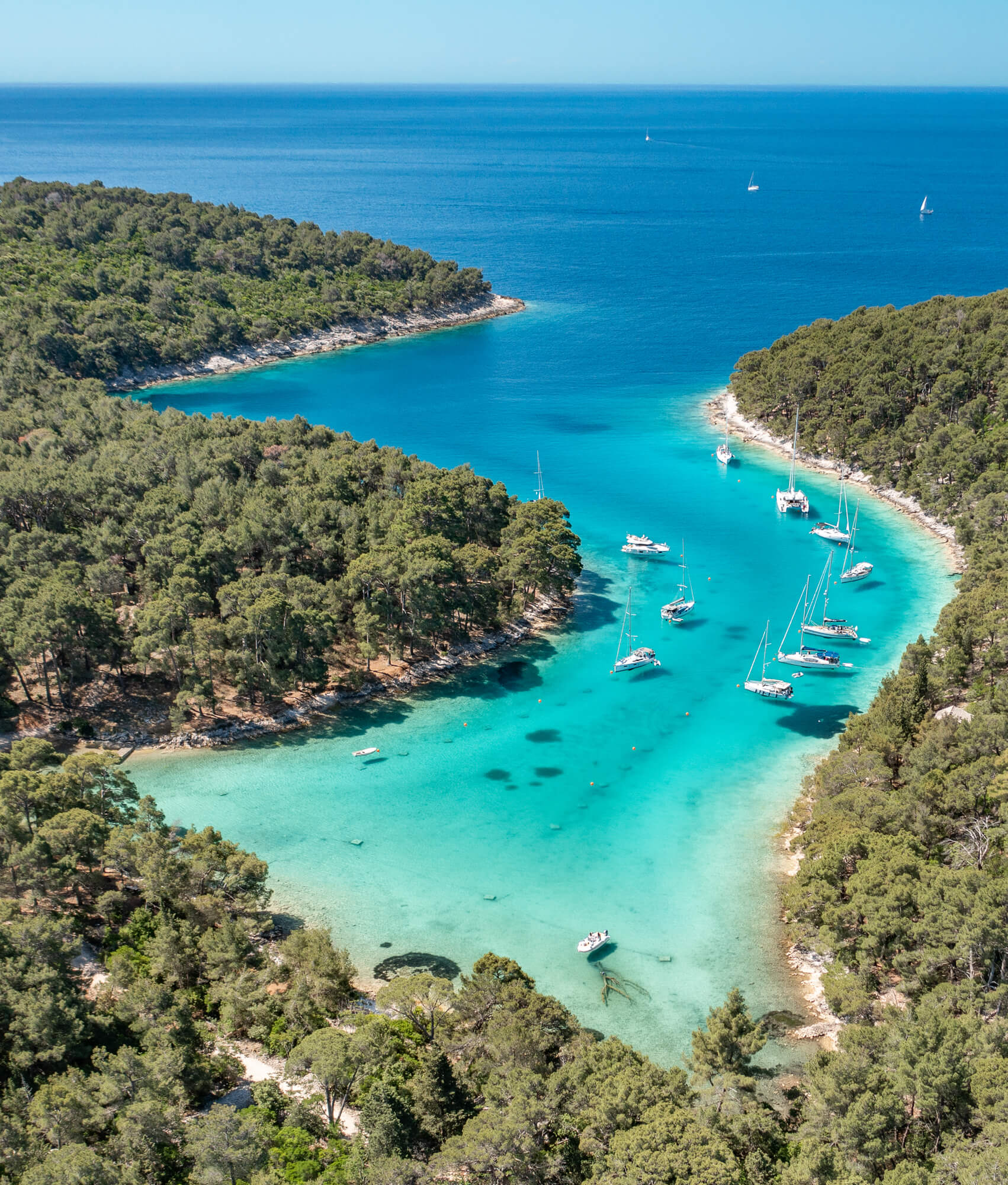
Krivica Cove and beach, Lošinj (Photo: Timotej Gošev)
Now I live in Croatia, but for 24 years of my life, my only reference was what I saw on the internet and on social networks. Now that I have spent two summers here, I can attest that Croatia has the advantage of meeting the expectations of those who came with a preconceived image in their heads. Those turquoise and transparent waters that you see in photos and videos, they are like that! But the Adriatic coast of Croatia is very extensive, and to it, we must add its more than 700 islands. Imagine the number of remote and wonderful places along almost 6000 kilometers of coastline that must exist to fulfill your fantasy of an Adriatic summer. Well, a Croatian photographer is dedicated to exploring, capturing, and sharing the magic of these places with his thousands of followers.
If you have looked for photos of Croatia to corroborate what everyone is surely saying about it, chances are that you have come across Timotej's photos. Also, if you have seen one of his photos, it is most likely that you have already bought your air ticket to spend the following summer in the Adriatic.

Lopud Island (Photo: Timotej Gošev)
Croatia will always stand out for its history, and its stories. But being someone who has lived most of his life on another continent, I am aware of the visual impact that Croatia has on other countries in the world. Especially in these times, many friends shared with me photos or videos that they found on Instagram, Facebook, Pinterest, TikTok, or Twitter, and they could not believe that such a place existed, and especially in Europe. When it comes to paradise islands and turquoise waters, many think of Hawaii, the Caribbean, or the islands of Melanesia. But Croatia has already positioned itself as an alternative Eden, and one that combines dream destinations and a calendar packed with cultural activities.
I find it impressive that a photo is able to motivate someone to book airfare and accommodation. I think this reinforces the idea that the world is there to be explored, and that Croatia is one of those must-see destinations in it. But for this to work as it has been working in recent years, it is necessary that all the tourism promotion forces in the country aim towards the same objective. There is the National Tourism Board, the local Tourism Boards, and why not, talented Croatian citizens who use their platforms and content to highlight their country in a showcase.
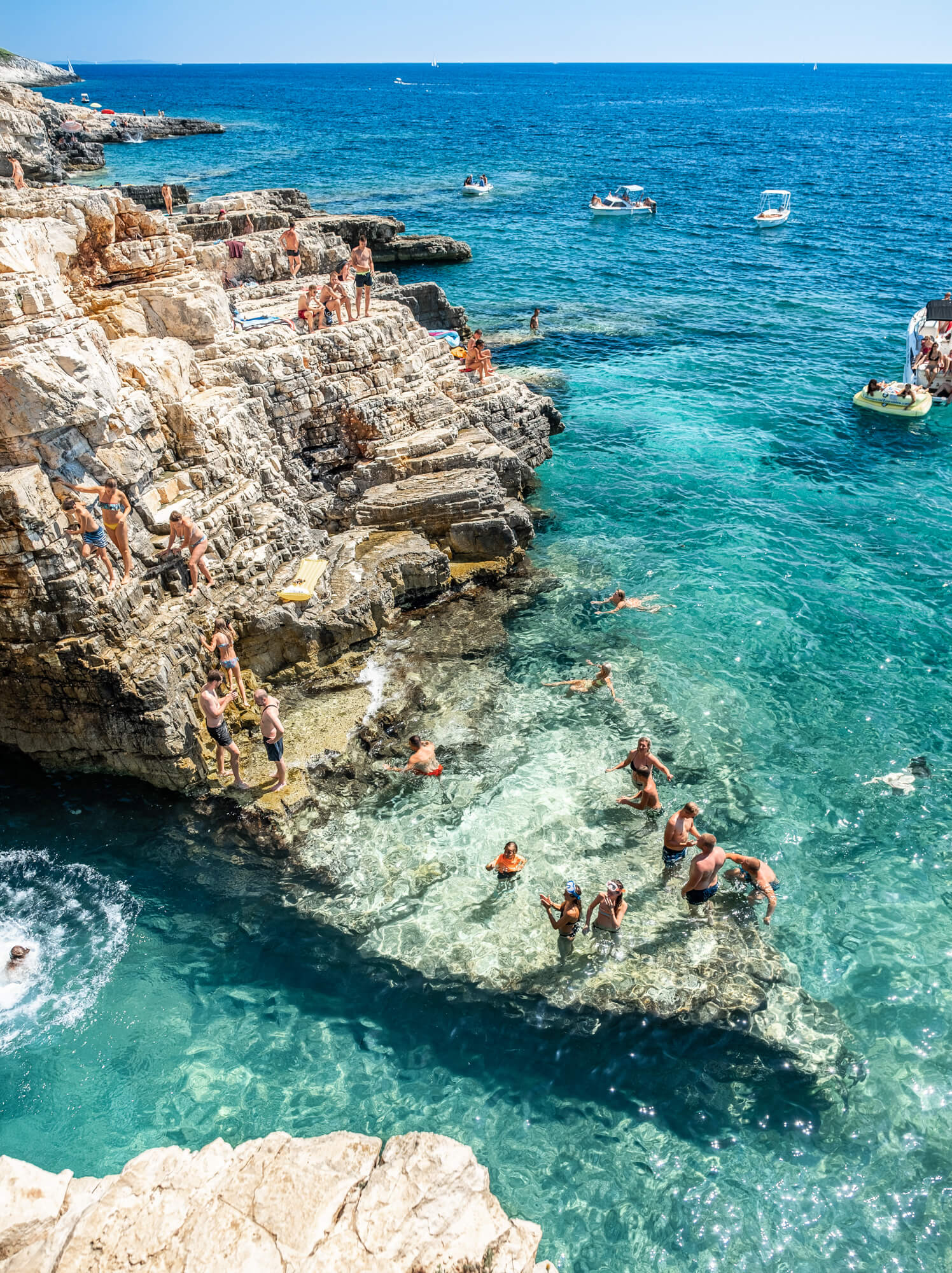
Kamenjak, Istria (Photo: Timotej Gošev)
One such person is precisely the famous Croatian photographer Timotej Gošev, who's approaching his mid-thirties, and currently living in Berkshire, England. He's the owner of the @timotej Instagram account which has become one of the largest social media accounts in the world by sharing travel photography and recommendations from only around Croatia. With almost 100 thousand followers on Instagram, his pictures often go viral and are reposted and shared by some of the biggest media groups such as Forbes, Conde Nast, as well as the biggest re-sharing travel accounts on Instagram such as Earthpix, Travel & Leisure, Wonderful Places & Beautiful Destinations. If you haven't seen his photography yet, be sure to check his Instagram first. He also has an impressive guide to his top 30 favorite beaches in Croatia, you can check it here.
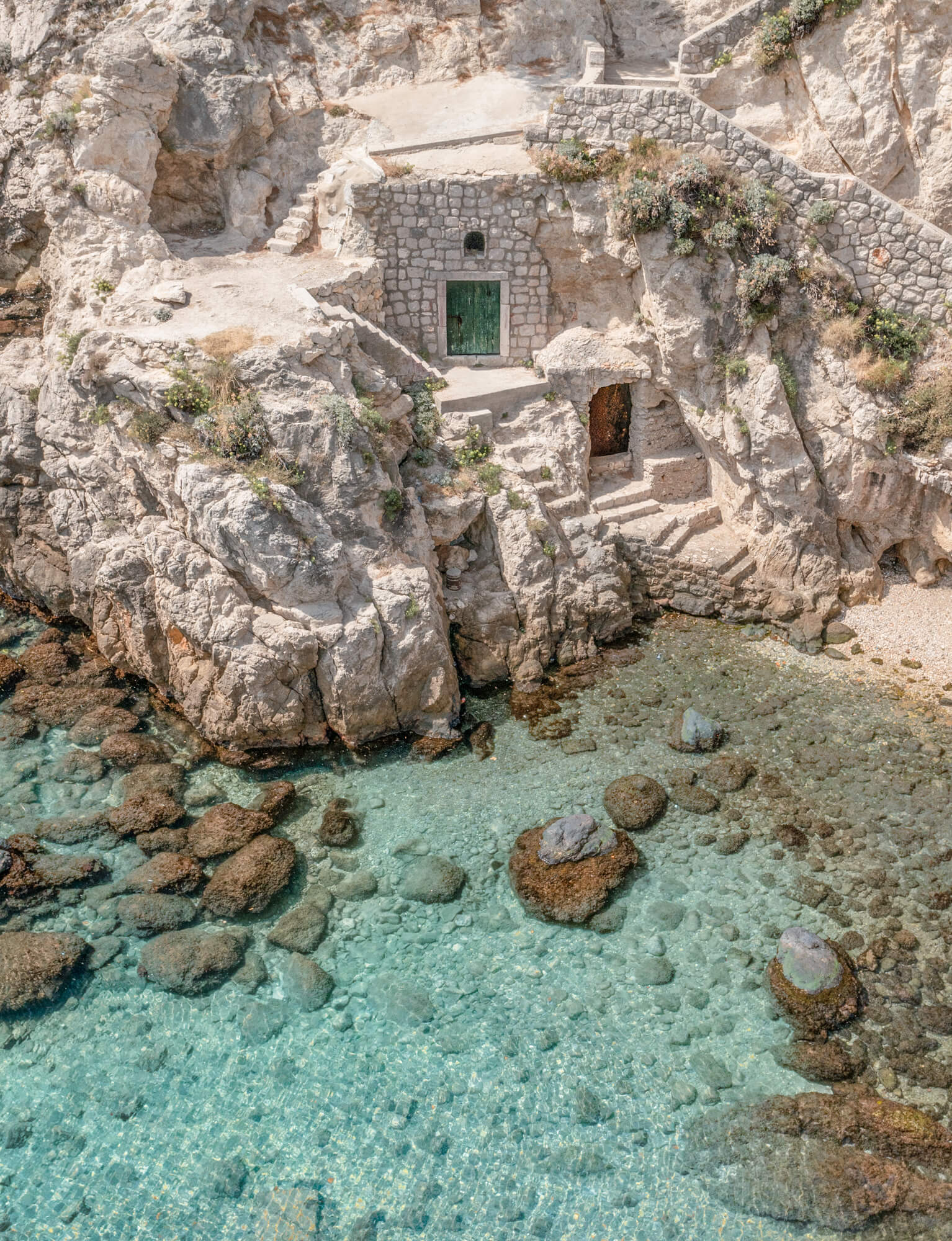
Dubrovnik (Photo: Timotej Gošev)
Timotej shares with Total Croatia News about his special connection to his country, his photography, tourism in Croatia, his future projects, and much more.
The vast majority of your followers and all of those who have come across your photographs on social media already know you for the quality of your work and your captivating images. But few know about your personal side and your history with Croatia. How does this connection with Croatia begin? Were you born and raised in Croatia?
It’s true. A lot of people see my photographs on Instagram, and just by looking at them can say this looks like one of Timotej’s photographs. However, very few people know me personally. Remember, I am a photographer sharing photos from around Croatia, through social media, to the world. I am not another influencer showcasing my life and hoping to influence you to be like me. My goal is to inspire people through my photography to visit and fall in love with Croatia.
It’s also very amusing to me, how so many people are surprised that I’m from Croatia. Even Croatians often assume I’m from somewhere else. I was introduced to Nina Badrić for example, and she knew of my photography but thought I was a Slovenian photographer. I think it’s purely because my name, Timotej (pronounced ‘Timo-tey’ in English), is not so common in Croatia. Think about it, most boys in Croatia are named after the first four books of the New Testament Bible. Ivan (John), Marko (Mark), Luka (Luke), Matej (Matthew). My mum wanted to be a little bit more original with her Biblical name choice, so she looked further down the list until she came to Timotej (Timothy). Simple and straightforward explanation.
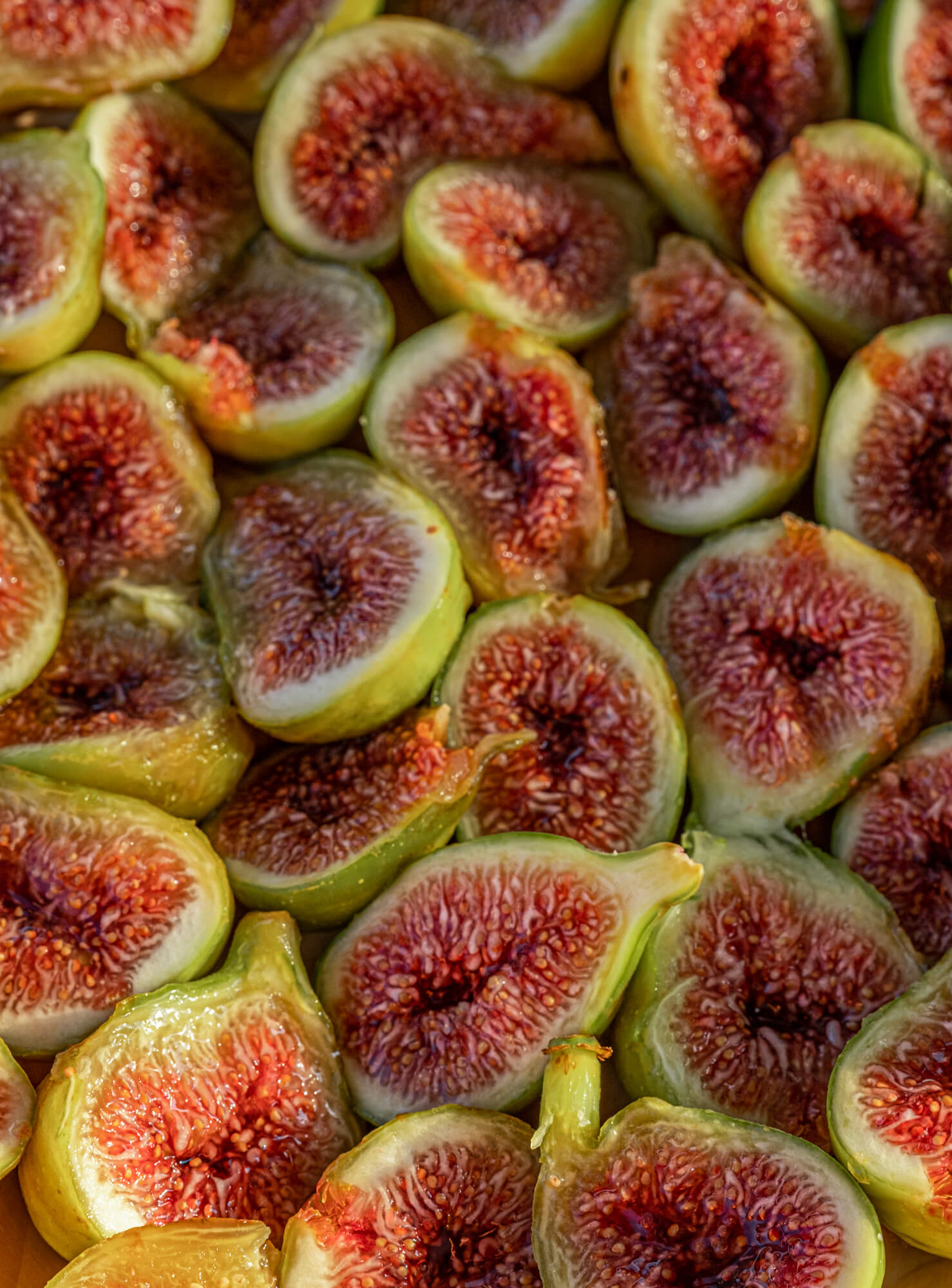
Croatian figs (Photo: Timotej Gošev)
My parents came to study in England after finishing their high school and army service in Varazdin, so I was born in the UK. But a few years later we moved back, so my younger brother was born in Varaždin. After a few years, my parents realized they could make a better life for our family back in England. So, once again, we moved back. Thankfully Croatia is just a drive and short flight away from England, so I was lucky enough to visit very often growing up. I can speak, read, and write Croatian too. I believe an Instagram account like mine, can only really belong to a Croatian, in love with his country.
Nowadays, when one associates the words ''travel photography'' and ''Croatia'', one of the first things that come to mind for a lot of people is ''Timotej''. How did you get started in photography and how has the learning process been so far? Is there another type of photography that you like equally?
I’ve been into photography for as long as I can remember. Cameras and lenses, all the gear, simply fascinates me. So does the quest to snap a perfect picture. As a child, I always wanted to press the camera’s shutter button and shoot everything. This wasn’t possible, as it was still the time of film cameras, and film roll was precious, so parents couldn’t let me waste it taking fifty pictures of nothing. So you can imagine my joy when digital cameras came into existence with memory cards.
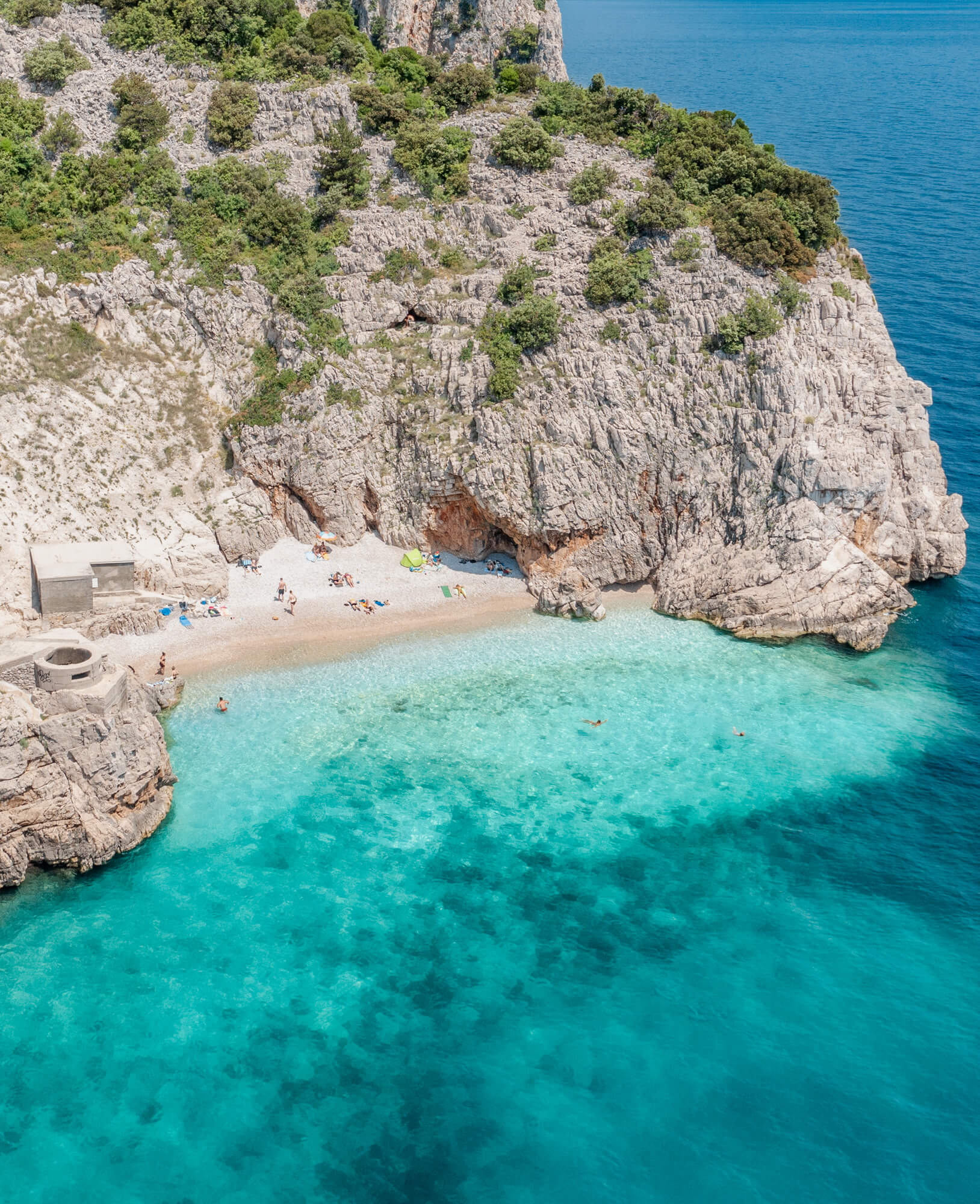
Brseč, Primorsko-Goranska (Photo: Timotej Gošev)
As far as learning goes, when you figure out how to work a camera/lens, the shooting settings, and how light affects the scene being shot, everything comes down to one’s eye for a good picture. Personally, for me, the learning these days mostly centers around training my eyes even more. If you take 50 shots, 1 can easily turn out perfect. But the goal is to be able to take 1 shot and make it perfect first time. Sometimes this means learning to be patient. Waiting. It can also mean making a bigger effort to find a unique vantage point. Doing research to find out what has already been shot where you are shooting.
I love beachscape photography as you all know, and architectural too. I also love to shoot macro shots. I really want to do more wildlife and food photography in the future.
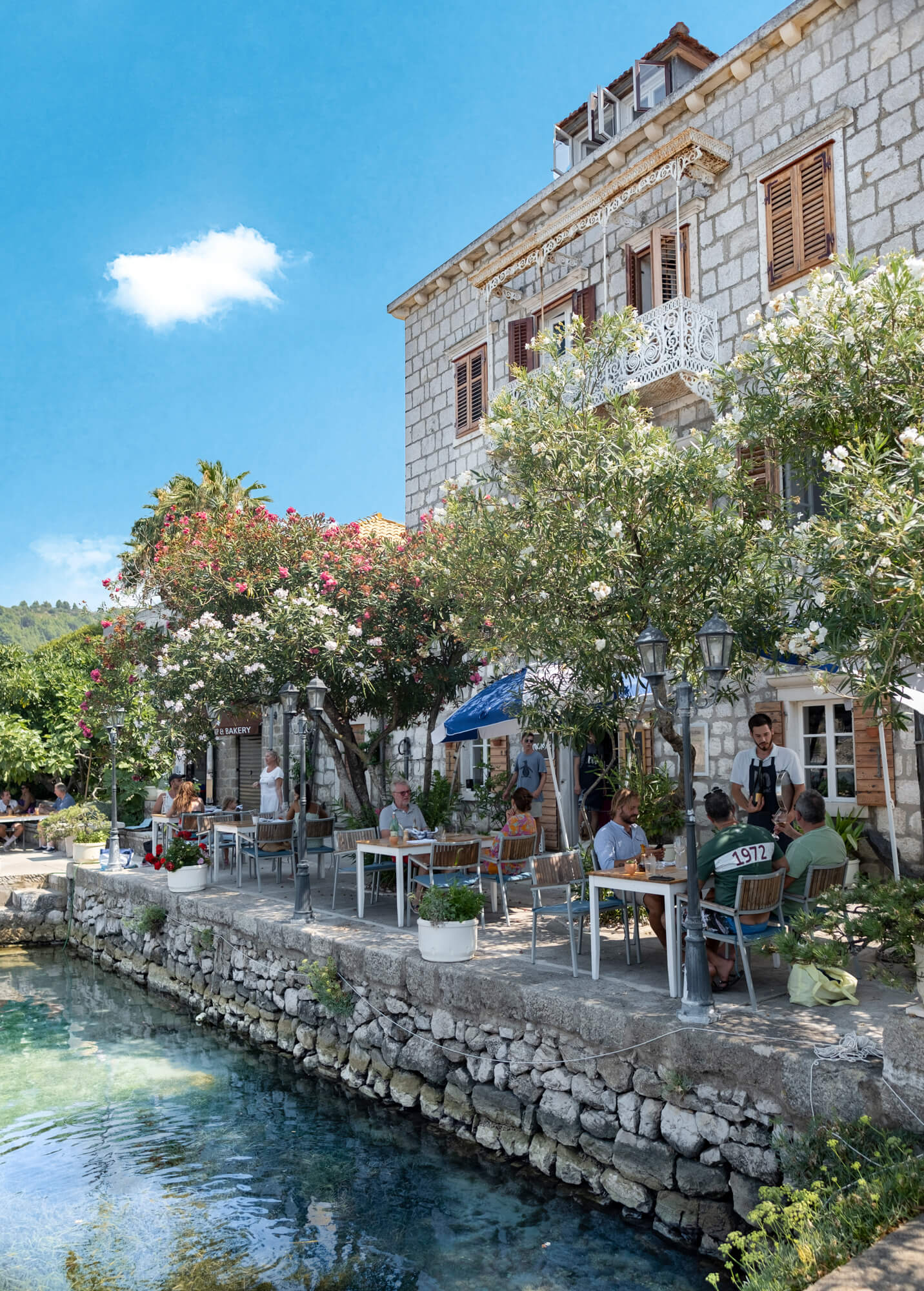
Restaurant Mandrač, Lopud Island (Photo: Timotej Gošev)
What inspires you to be a travel photographer and how has that changed in recent years?
I’m in love with the Croatian coast and the Adriatic Sea. Its beauty simply inspires me to capture it with my cameras. I am lucky and blessed to be able to call such a place, my country. I want to see and explore as many spots along the coast, and visit as many islands as my lifetime allows me too. Each place is its own world. People today are so obsessed with seeing as many countries as possible, but few have had the pleasure of truly knowing, exploring, and enjoying theirs. I love going back to a place I’ve already visited, to see how it’s changing, developing, and evolving. I am constantly inspired by the big and little changes happening everywhere. The way I see it is, that there is a lifetime of exploration for me and capturing moments with my camera. There is no getting bored.
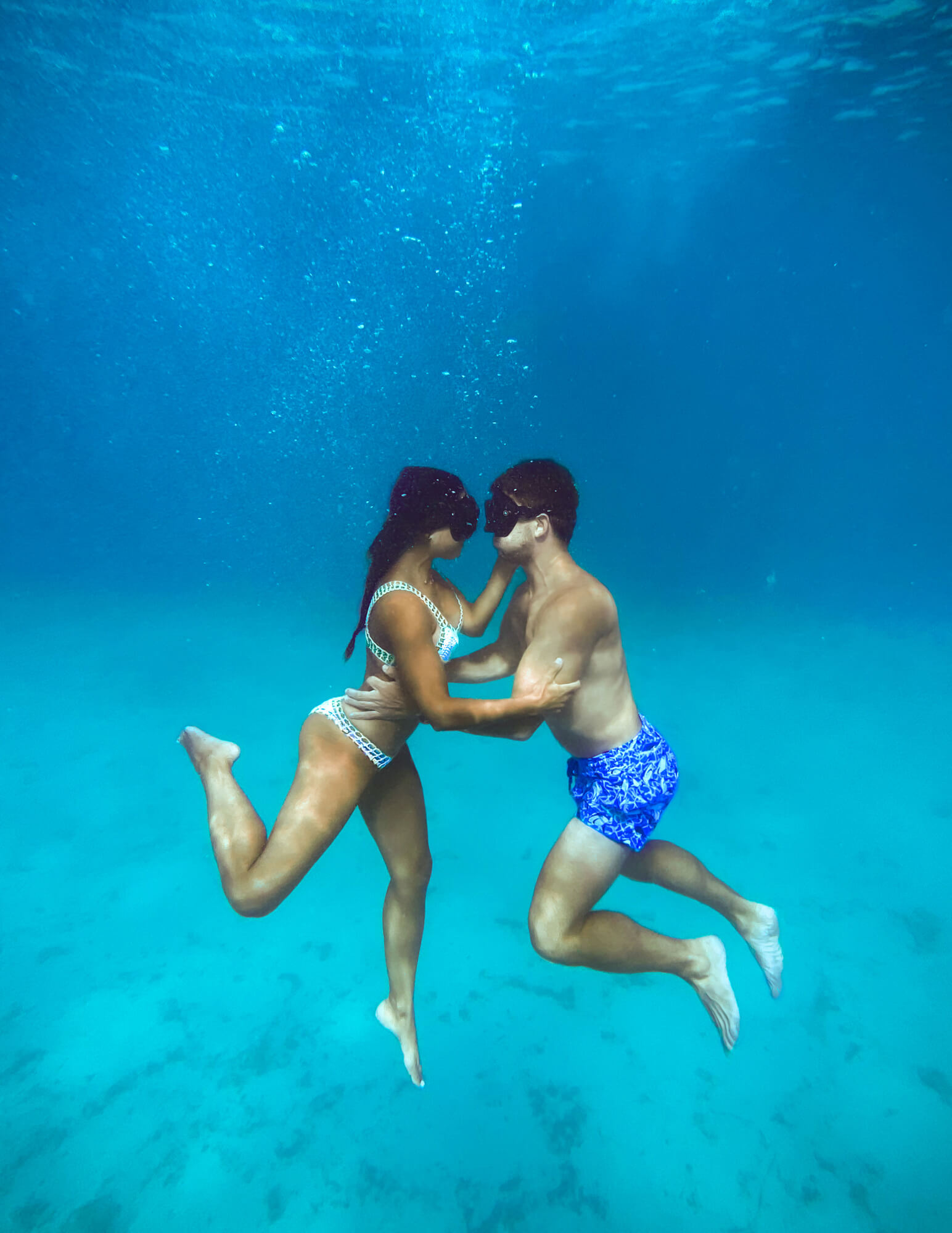
How do you manage to balance your time between the UK and Croatia? Has Brexit affected in any way the way you travel between the two countries?
I like to be in Croatia during the summer, so I can enjoy the sea and beaches. It’s where I experience the most joy. Since I got my driving license, I have been planning my life in a way so I could spend the maximum possible time in Croatia every summer. To my surprise, neither Brexit nor Covid19 has affected my travels to Croatia. I have dual nationality. Croatian and British passports and therefore was legally allowed to travel to go to either home. With negative PCR test results, I drove England to Croatia three times during the pandemic. When you have a registered photography business in the UK, going to Croatia to shoot photos is a legitimate and valid reason to travel for work too.
How would you describe the personal style behind your photography? And how about your visual style?
I want people to look at my photographs, and simply desire to be right there in the place their eyes are seeing. To imagine themselves living the moment being shown. My photos need to mentally seduce and show the essence of an Adriatic summer experience in Croatia. People think my visual style is really unique, but it’s a classic beachscape visual style used in travel magazines and by some of the world’s most known beachscape photographers for decades.
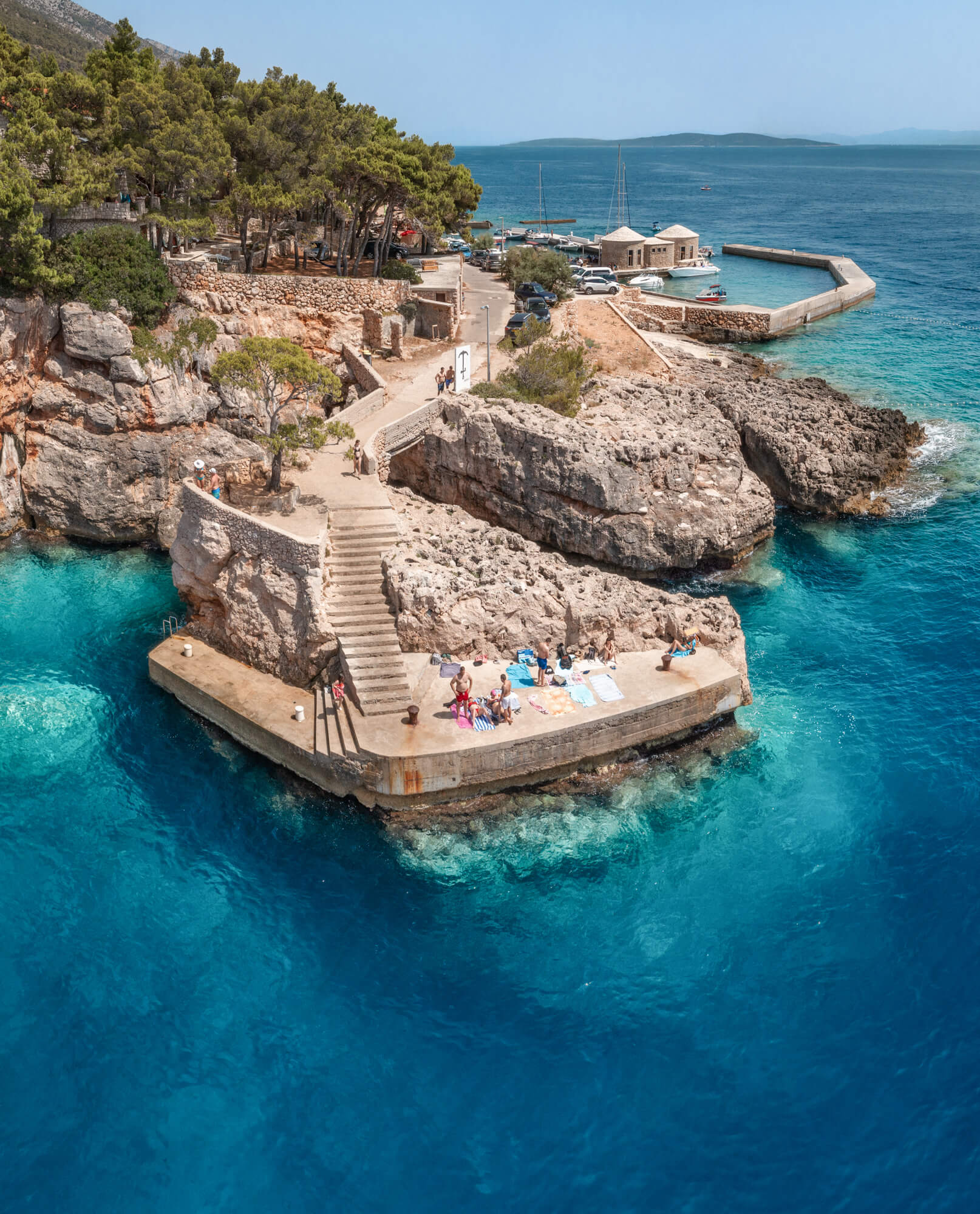
Sveta Nedjelja beach, Hvar (Photo: Timotej Gošev)
It is a beautiful summer day in Croatia, how does Timotej spend it from start to finish?
I like to wake up early. No need for coffee. I really believe in seizing the daytime. I want to be the first on the beach. Put my towel in the best spot, and go for a morning swim to truly wake up. Love soaking in the early morning sun too. Around 9 am, it’s time for a light breakfast, and then back to the beach where I’ll stay until lunchtime being as active as possible. I prefer to stay in apartments, so for lunch, it’s usually time to cook something, rather than eat out. After lunch, it’s back to the sea/beach until sunset. The afternoon is usually about exploration. Then shower, dress up a bit and go to town for dinner and some ice cream. I always end up chilling on apartment terraces late into the night, always in good company getting into deep conversations.
It has happened to me on several occasions that I have decided to put my camera aside so as not to miss the experience. How do you manage to consistently create content and live in the moment at the same time? Do you have any advice for other travel photographers?
It’s actually very simple for me. When I go to a place in Croatia, I am not going there to take a picture. I am going there to enjoy the experience and moment of being in a place which brings me total joy. I live the moments fully with my camera at home, or in my backpack. After I enjoyed the place, explored it, I come back with/take out a camera. Also, I don’t live from making social media content and I don’t have any pressure to create content. My advice to travel photographers is that when you decide to shoot a place, make a decision to spend at least 1 week there. Don’t follow the content creator crowd, and a lot of Croatian photographers, are doing this, in that they go to a spot for a few hours with the purpose of taking a photo and then off to the next location.
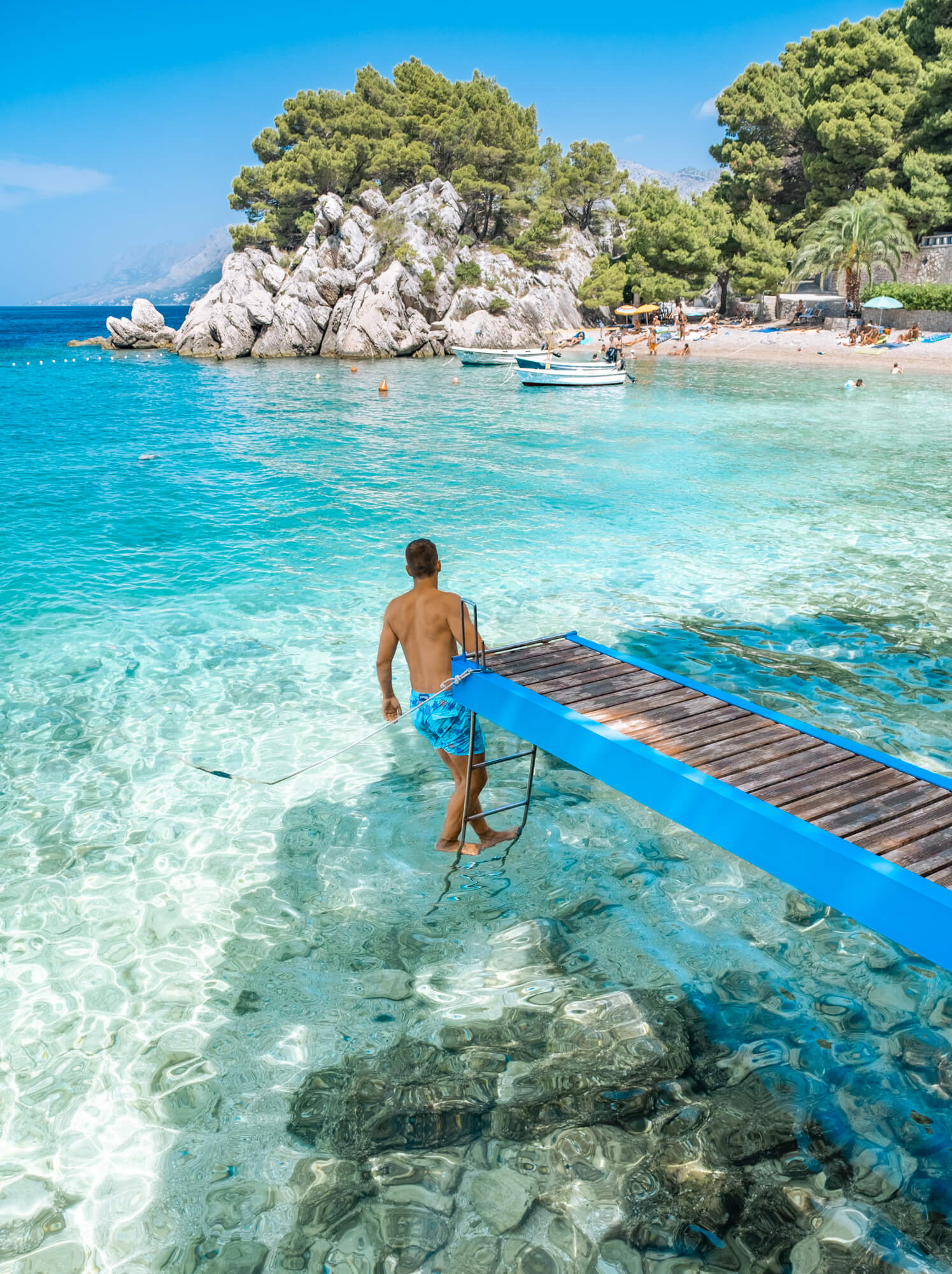
Brela, Dalmatia (Photo: Timotej Gošev)
A photographer was telling me how they photographed every nice spot on Korcula Island in 1 day. Don’t make this same mistake. The world’s most famous beachscape photographers, when shooting a particular area, commit to spending a whole summer season there, chasing the billion-dollar shot, as we say. I can’t commit to a whole summer in one spot yet either, but everyone can do 3-7 days. 1 to enjoy without smartphones and cameras at least.
It could be said that you lean more towards photography of landscapes and places, but would you like to also venture into a type of travel photography where you can also highlight the Croatian people, their traditions, and their customs?
My focus is the Ljeto (Summer) in Croatia. The goal is to photograph and show the summertime experience. Naturally, there is a lot of landscape shots. But if you have been following me for a while you also see the entire summer experience. If I go into town at night and see a cultural dance, or traditional outfits, if I like what I see, I will photograph it. But right now, the priority is to show beaches and nature, accommodation, and things one can experience when visiting Croatia in the summer. I am showing what my audience wants to see.
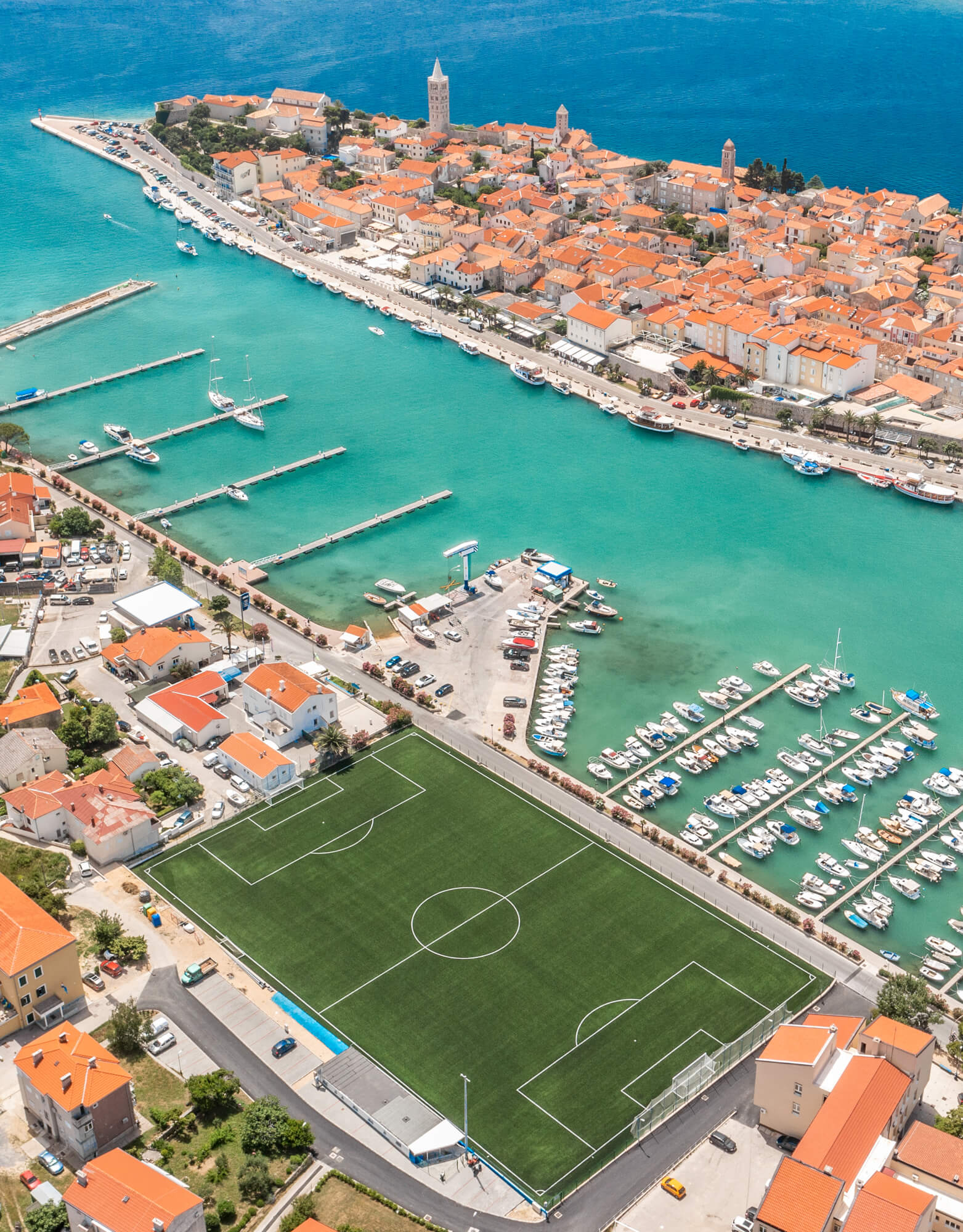
Town of Rab (Photo: Timotej Gošev)
However, if Drago Sopta retires, I would gladly like to venture off and take over as the photographer of the Croatian National Football team and take pictures of the guys playing football. I believe in myself as a photographer, and my ability to shoot in a variety of styles.
It is said that there is an excessive amount of drone images to visually promote Croatia and that they do not accurately reflect the possible experience of a tourist (for example Izvor Cetina or the Croatian islands from above). But you manage to combine both images with a drone as well as those from a personal point of view. How can both promote tourism in Croatia?
Look, Zlatni Rat Beach shot with a drone, from above, looks like one of the most beautiful spots in this world. It’s unreal. Then you come there, stand on the beach, and you can’t really see it from the vantage point the drone did. So you now have two options. The first is to get upset, choose to be negative, and leave disappointed, as many do. Or you can think about it, and say to yourself, I’m standing on this magical beach full of shape-shifting pebbles, surrounded by perfect water, and enjoy the beach all day. Every destination spot in the world that looks good from above is excessively photographed with drones. Those saying it doesn’t accurately reflect the tourist experience are a very small minority, and they are there for the wrong reason in my opinion. I believe you need both to give the true picture to someone. Let them know what it looks like from above and below. Balance is key. I like to show how it looks from ground level and from the sky.
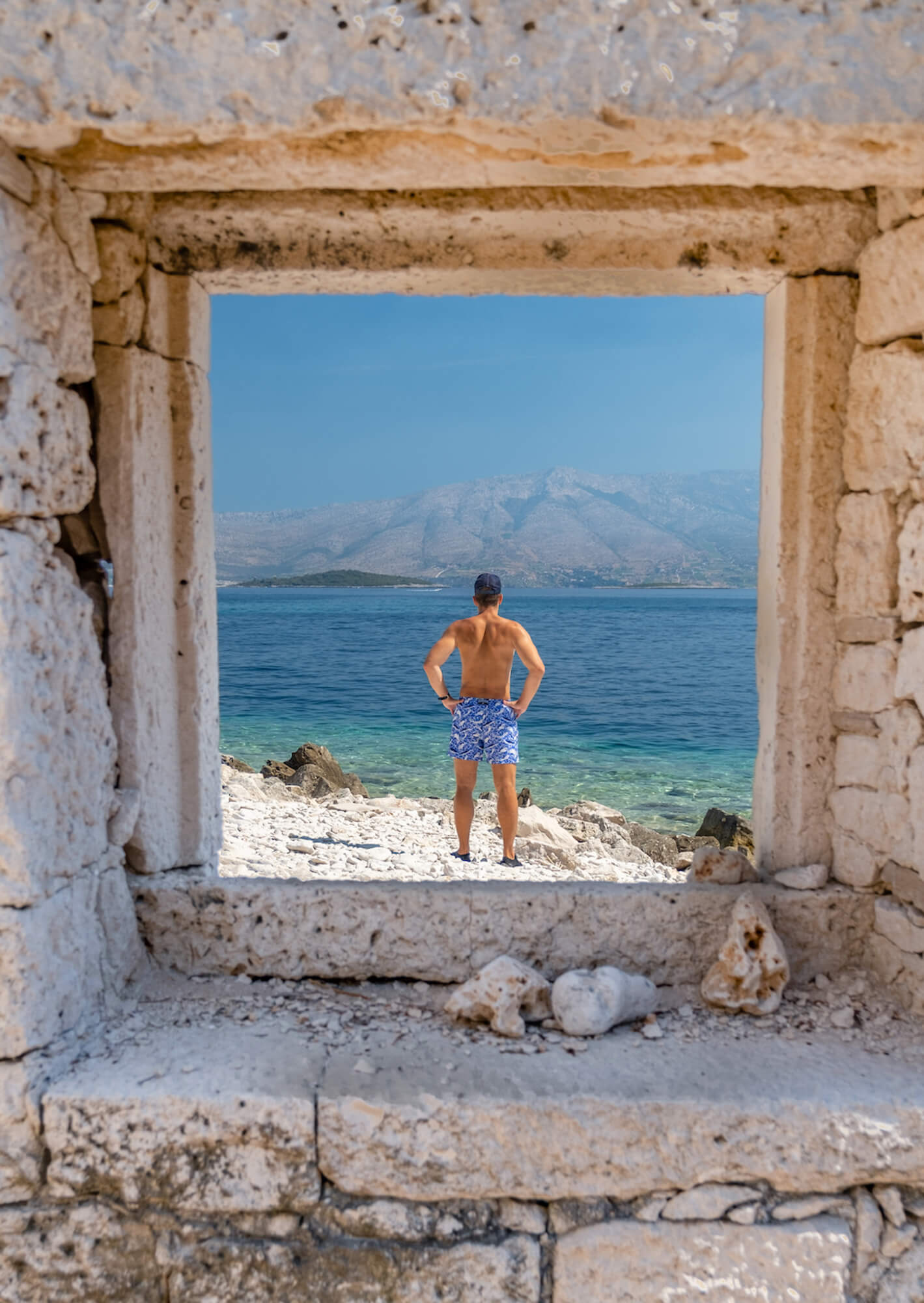
Otok Vrnik (Photo: Timotej Gošev)
Many content creators avoid bringing discussion topics to their feed to avoid losing followers or getting into disputes with them. But in addition to visually promoting Croatia, you also take the time to raise awareness about caring for the environment, such as animal rights and the situation about smoking in Croatia. Is it necessary for content creators to be ambivalent in that regard? What responsibilities should someone with so many followers and a lot of reach assume?
I always speak my mind. From day one on Instagram. I have my opinions, and my account is a space where I can share them as well as my photography. I don’t expect everyone to agree with them and that’s okay. Does Croatia have a smoking problem? Yes. Have tourists noticed it? Yes. Is it destroying our beaches? Yes. A lot of what I highlight are facts and truth. Common sense. It’s already been said by others, and it’s very much connected to keeping Croatia’s land beautiful and not destroying it. I don’t live from Instagram, so if I lost all my followers tomorrow, it does not affect me in any way. As for disputes, occasionally some arise, but surprisingly not a lot. I think the things which I’m highlighting are things the overwhelming majority of my followers agree with me on. We all want to keep Croatia clean and beautiful for generation after generation.
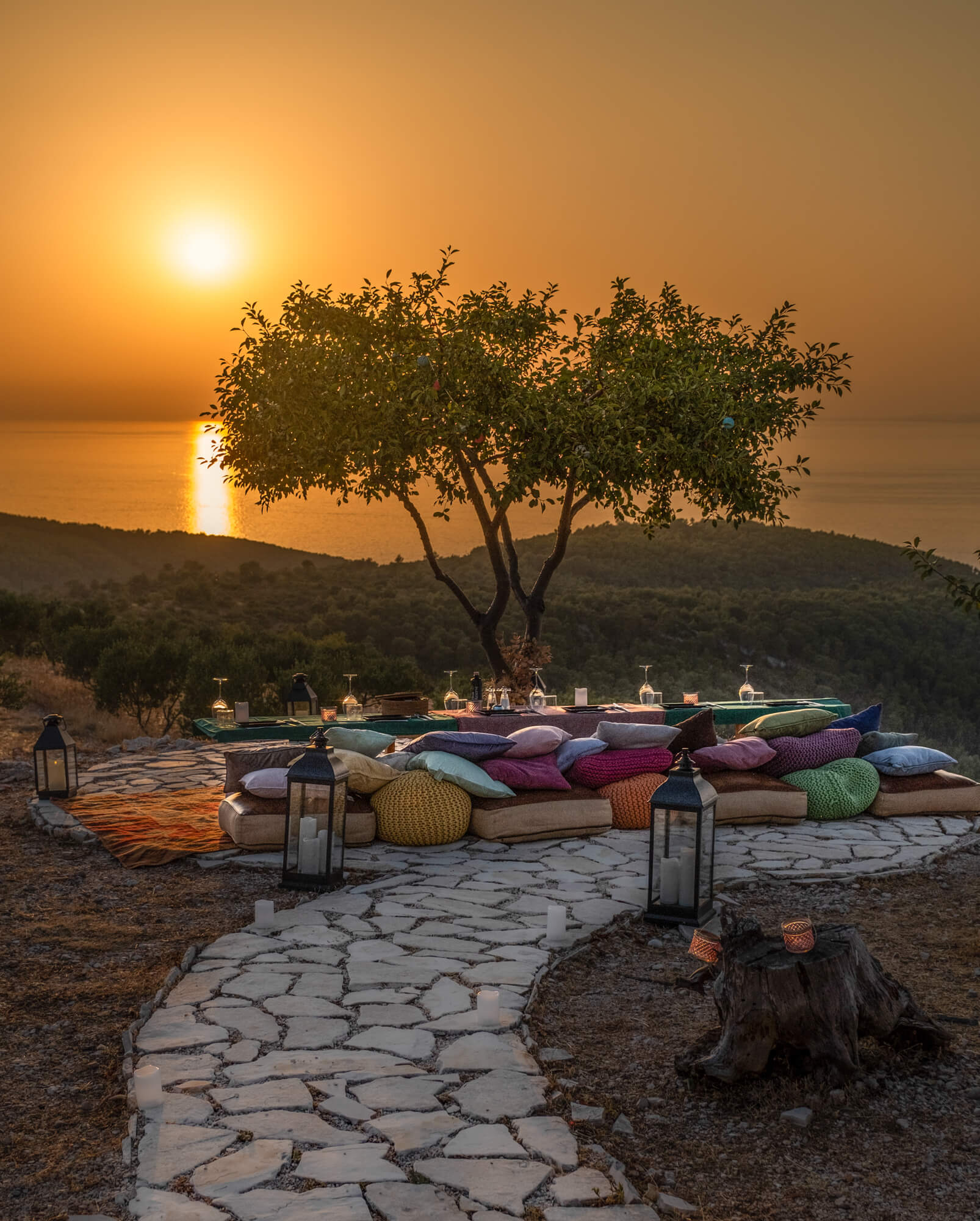
One Table Restaurant, Hvar Island (Photo: Timotej Gošev)
Regarding the promotion of tourism in Croatia, what aspects and efforts made by the national and local tourist boards in the last two years can you highlight?
I don’t see anything the National Tourist Board does, and as the majority of the tourist sector in Croatia, see them as irrelevant, and a waste of taxpayers’ money. The Local Tourist Boards, on the other hand, are great. I’ve had the chance to work with a lot of them now. It’s hard to keep everyone happy, but they are doing their best. I can say and see they are finally embracing social media, and valuing its importance more than ever. Making sure they have a strong social media presence, as well as using people like me, and other Croatian photographers to showcase their tourist regions to the world.
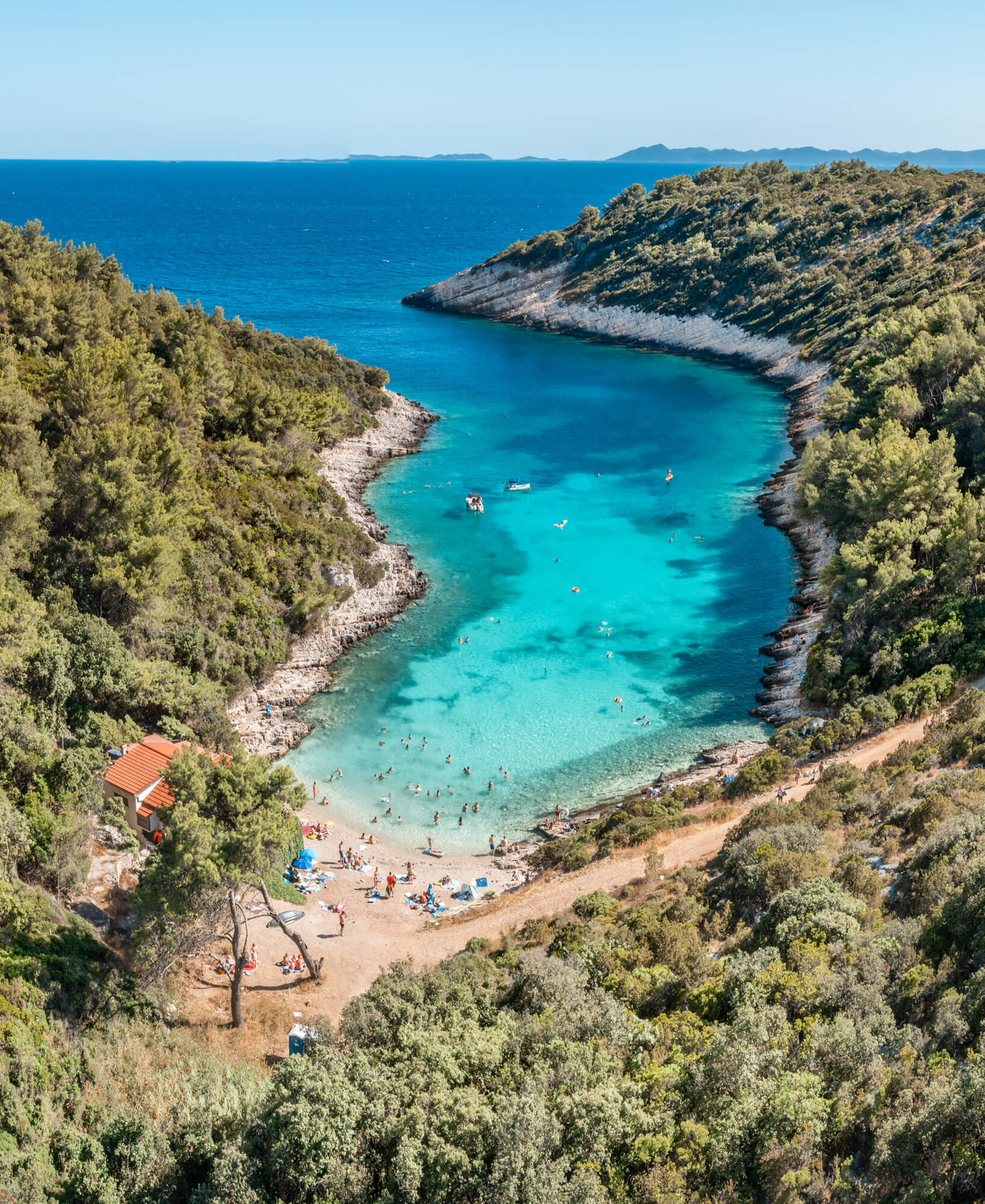
Žitna Beach, Korčula Island (Photo: Timotej Gošev)
In what aspects do you think the promotion of tourism in Croatia should improve? Is there something you can criticize?
The biggest issue I noticed is the relationship between the local tourist boards, and the locals working in the tourist sector. It seems everyone is against the tourist boards and everything they do, with only a small minority pleased. I’ve been to places, and I like to talk to locals, and the moment they find out I’m involved with the local tourist board, they don’t want anything to do with me! Why? Well for starters Local Tourist boards should have nothing to do with political elections and political parties. The tourist boards should exist to serve the tourist, those offering tourist services, and they should be neutral. Also too many tourist board employees, naturally have friends working in the tourist sector and thus drive tourists to only use their services. I think you can guess what kind of issues that can create. The tourist boards should be the pride of the local tourism sector. A fair helping hand, letting the tourists know all their possibilities. Show them all the options on offer, and let them choose which to go with. I also really think it’s time for an official tourist app, where everyone in the tourist sector can list their tourist offers for free. Create it with taxpayer money. Tourists can use the app to find out and search for everything. Beach information. Boat rentals. Taxi numbers. Available accommodation. In 2021, one shouldn’t have to go to a tourist office for information anymore.
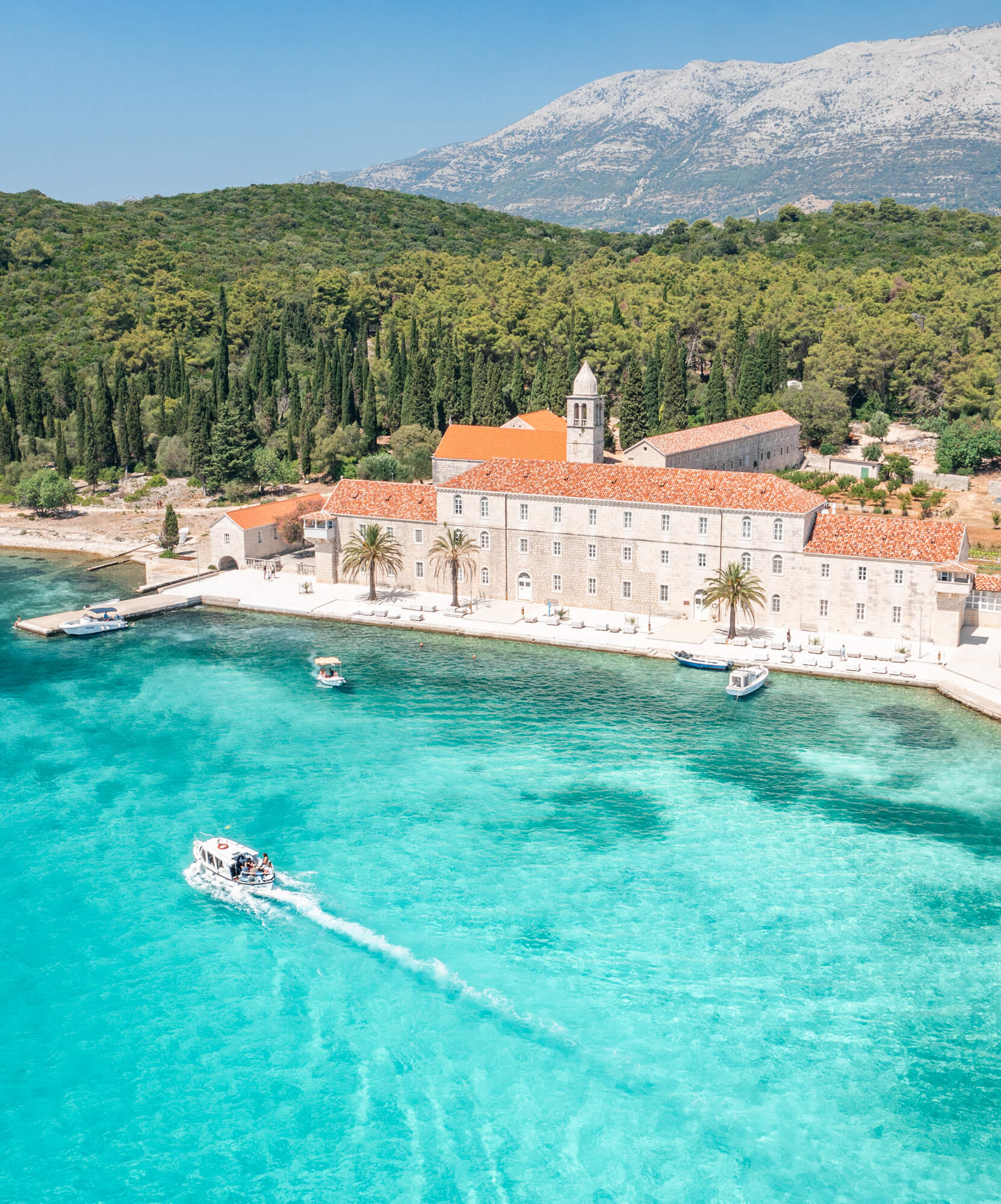
Badija Island (Photo: Timotej Gošev)
In what ways can photographic content contribute to effective tourism promotion in Croatia? How important is it?
People travel to different places in the world for different reasons. Everyone is looking for something specific. An image they have seen either in a photo or video usually serves as the primary mental motivation for doing so. They want to see that image with their own eyes. I have always argued that people come to Croatia first and foremost for the natural beauty of the sea and beaches. The old towns. Natural parks. I loved our old tourist slogan, the Mediterranean as it once was. So, before booking a flight or hotel, people want to know what the particular area they are potentially going to visit has on offer. I have been the first Croatian photographer to share certain places in Croatia on Instagram for the very first time, and the response was, we had no idea this place existed.
I’ll give you a personal example. I grew up spending summers around Zadar. Since I was a kid. Only recently as an adult, I discovered one of the most beautiful spots in Croatia. Vrsi, right by Zadar. I never saw this spot advertised anywhere. So I never went there. Some beaches like Zlatni Rat were advertised everywhere, so normally, I went there, and it was crazy crowded. By showing a little bit of every place, you are now giving people the choice to go to so many places.
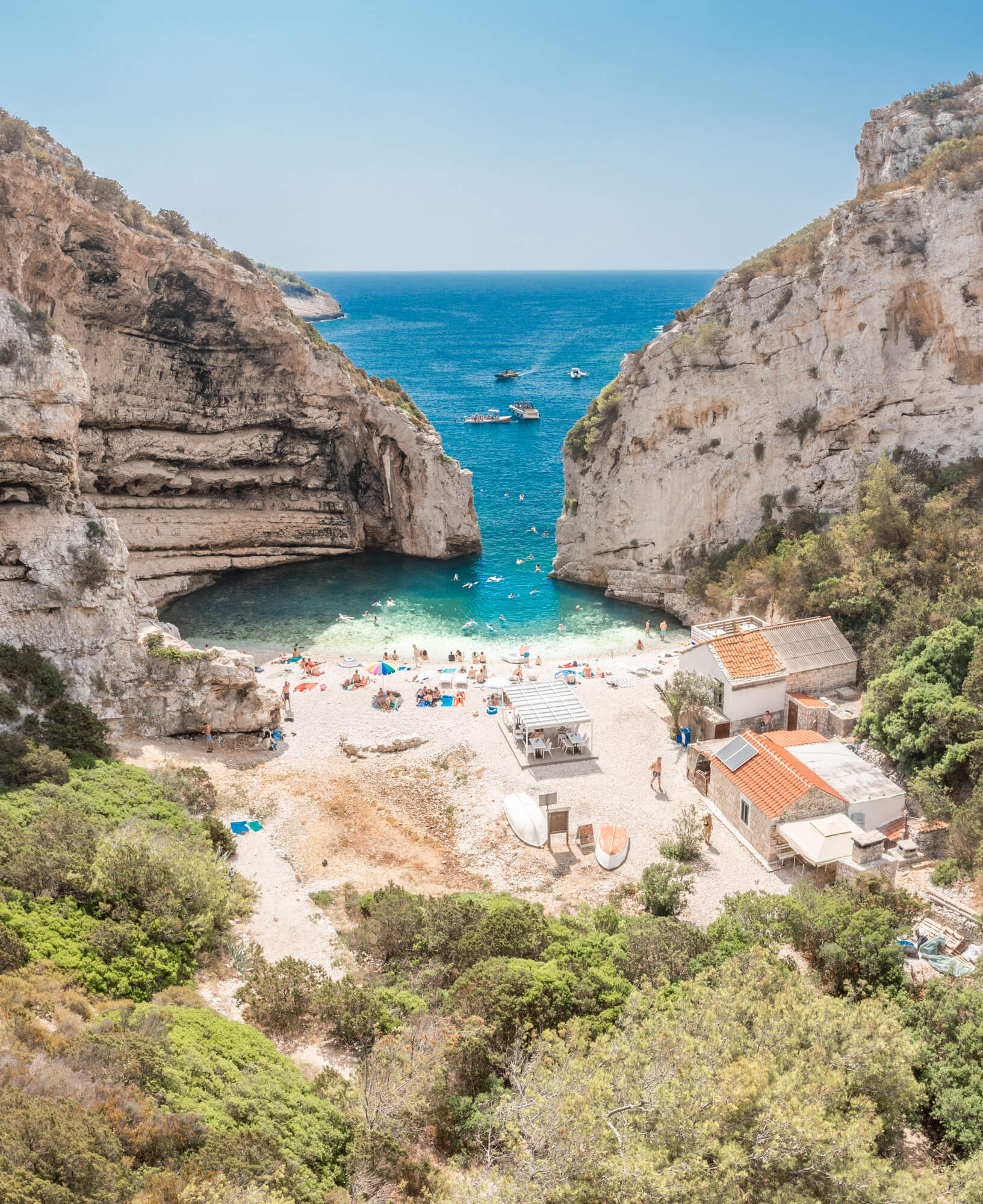
Stiniva Cove, Vis Island (Photo: Timotej Gošev)
If you could describe Croatia to your followers as an ideal travel destination, based on five unique aspects, which ones would you choose?
1. Raw natural beauty everywhere. 2. The crystal clear blue water. 3. Safety. We are an extremely safe country for tourists throughout the day and night. One of the lowest crime rates in the world I believe. 4. Quality of food and drink. 5. There’s something for everyone.
Is there anything in particular in Croatia that catches your attention and would you like to investigate further? I have seen that at some point you inquired about the history of abandoned stone houses on the Croatian coast and islands. It is really a fascinating subject.
The abandoned stone houses are a sad story. I really hope the property ownership laws change soon. They are killing Croatia. A lot of people say it’s impossible. But I believe there’s an easy fix to it if you apply common sense. Pass a law, that every property in Croatia within 2-3 years has to have one owner owning 100% of it. No more multiple owners, owning small percentages. If some owners can’t agree on a deal between themselves, it goes to auction among all the owners, and the highest bidder gets the property. Why hasn’t this happened? I hear lawyers in Zagreb make a killing on these property disputes. I also think Croatia has a serious waste management problem. Especially on the islands. I’ve heard shocking accounts from those who live on the islands about what really happens with the waste tourism generates. I think the situation is worse than many believe. And if that’s really true, we need to do something about it. I truly believe the world sees Croatia as a clean country where natural beauty can be seen in abundance which is its biggest selling point. The land is really ‘Lijepa Naša’ and it needs to stay that way.
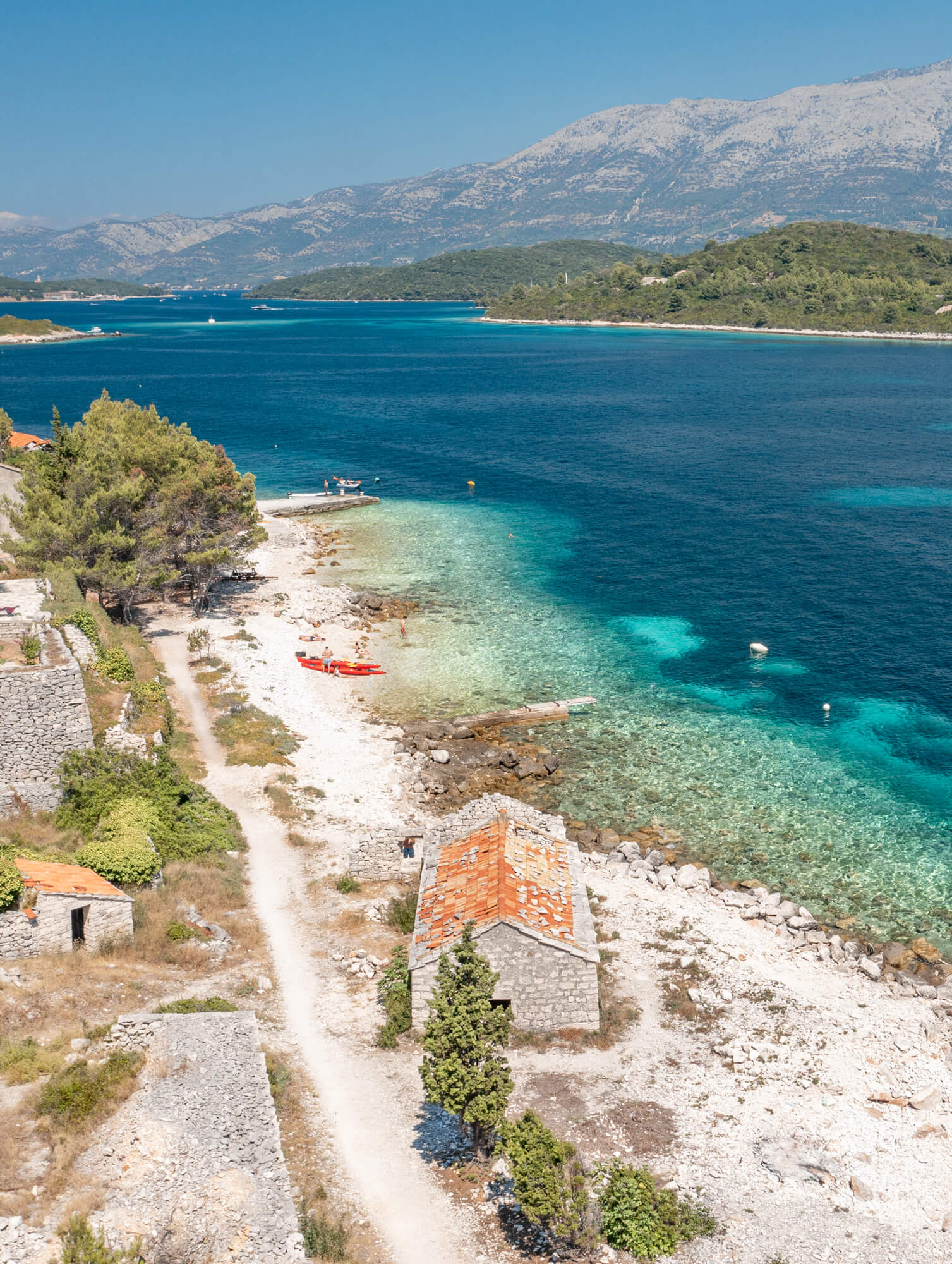
Otok Vrnik (Photo: Timotej Gošev)
Connected with this issue are the party sailing trips such as The Yacht Week. Everywhere they go, they leave so much rubbish behind it's unreal. In the sea. I’ve seen it. Again and again. All the locals I meet in the entire tourism sector as well as those simply living in the spots The Yacht Week comes by, wants these party sailing holidays banned. It’s beyond me how this hasn’t happened yet. Whoever is giving them the green light to continue summer after summer needs to be put in the spotlight.
Besides being a travel photographer, do you also consider yourself a travel journalist? Many content creators upload their photos or videos and that's it, but you like to include reflections, chronicles, and recommendations alongside your images. Is it something that you are interested in developing further in the future?
I grew up reading travel magazines like Conde Nast, and I currently collect travel-themed coffee table books full of pictures with text. There’s always a story behind what you see in a photograph and something to learn. I do consider myself an excellent writer in the English language. People have noticed this, and this past year, a few travel magazines and a national airline, asked me to write for them about Croatia, as well as showcase my photography to their readers. I hope more people will ask in the near future. It’s something I love doing.
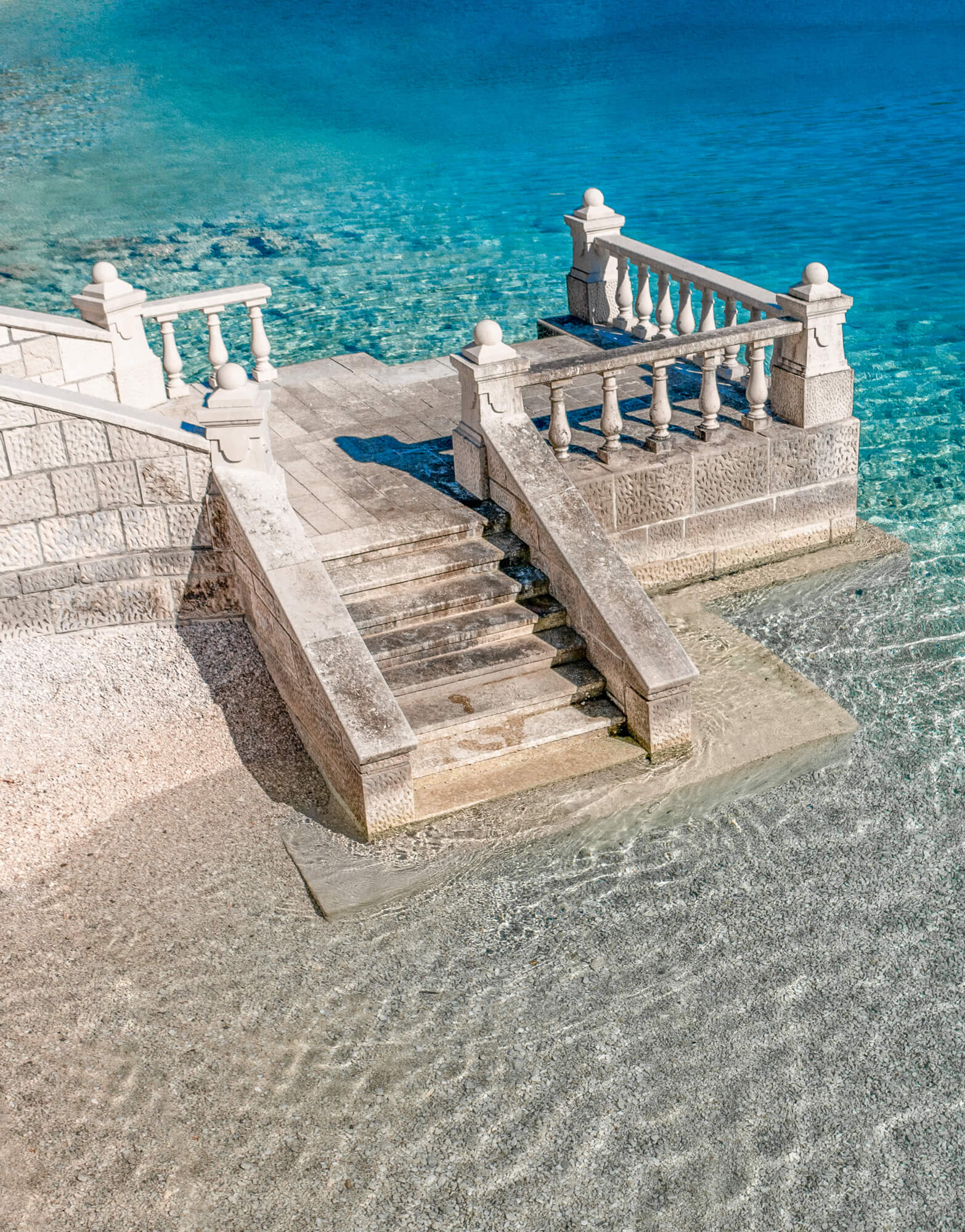
Čikat Bay, Lošinj Island (Photo: Timotej Gošev)
What does your Instagram profile look like on a summer day in Croatia? How do you usually interact with your followers or people who need help or recommendations?
During the summer the plan is to share 2-3 posts a day. The pictures being posted are usually what I photographed 1-2 days prior. Also, because we are in the summer season, many of my followers are currently in Croatia, or about to visit. This results in a crazy amount of questions. I used to answer every question without fail in previous years, but with an increasing number of followers, it’s impossible sadly. Remember I’m not getting paid to do this. It takes a lot of time. This summer I was receiving roughly 300-500 messages a day. A lot of people also don’t read the caption in my posts and then send messages, for example, asking what’s the name of the beach in the picture I just posted, without making an effort to read the caption where this has already been stated. This is very frustrating. However the questions generally are usually based on recent posts, so I try to answer a lot of them in one of the next posts or stories.
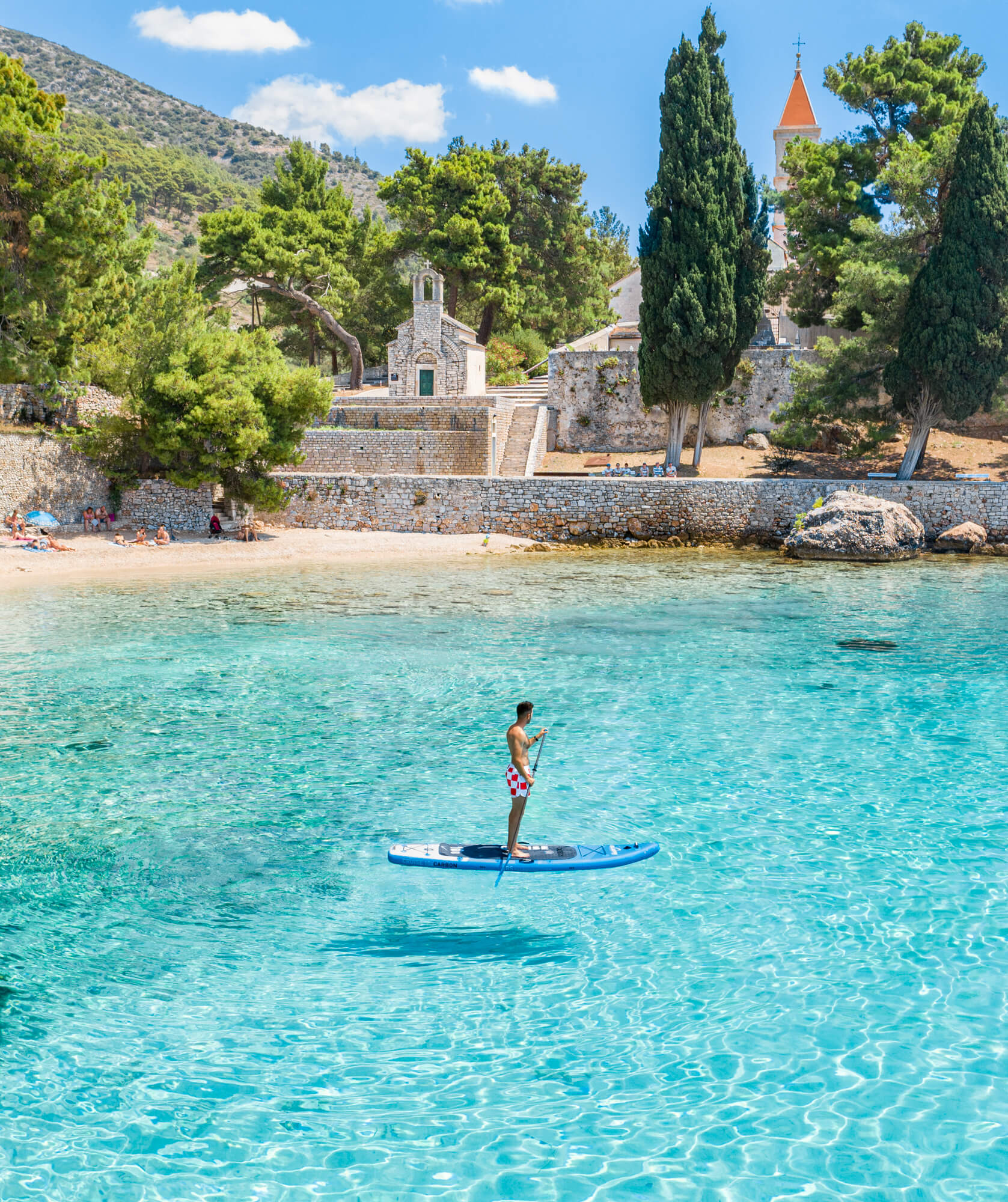
Bol, Brač Island (Photo: Timotej Gošev)
Besides photography, what other things do you spend your time on? Do you have any other interests or hobbies that are just as exciting?
Out of the summer season, I live in England, so when I’m not working, I really love to play sports. I play football, basketball, volleyball every week, competitively. Then there’s gym and lap swimming. I’ve always been into cooking too. So, always trying to master certain dishes and learn new ones. In the summertime, besides photography, it’s very much every activity connected to the water. I’m a big water sports lover. I love diving. I’m a very active individual. I love the company of friends too. I’m a very social extrovert that likes to laugh a lot.
What next projects do you have planned? What are the next steps in Timotej's life and career?
Oh, I have a lot of ideas. Some are already slowly turning into reality. I would love to see more art stores around the world selling my prints of beautiful beachscapes from around Croatia. At the moment it’s just a few in England. As well as being a good photographer, I also believe in my ability to capture video, so expect to see some epic short films soon. I’m also already working on my very own coffee table book taking you on a journey around Croatia’s coast and islands. I’m really excited for this. I have the photographs and text, and just need to find the right publisher to make the dream come true. Lastly, due to demand, I think I will slowly get into trip planning. So many people want me to plan their visit to Croatia. I’m honoured.
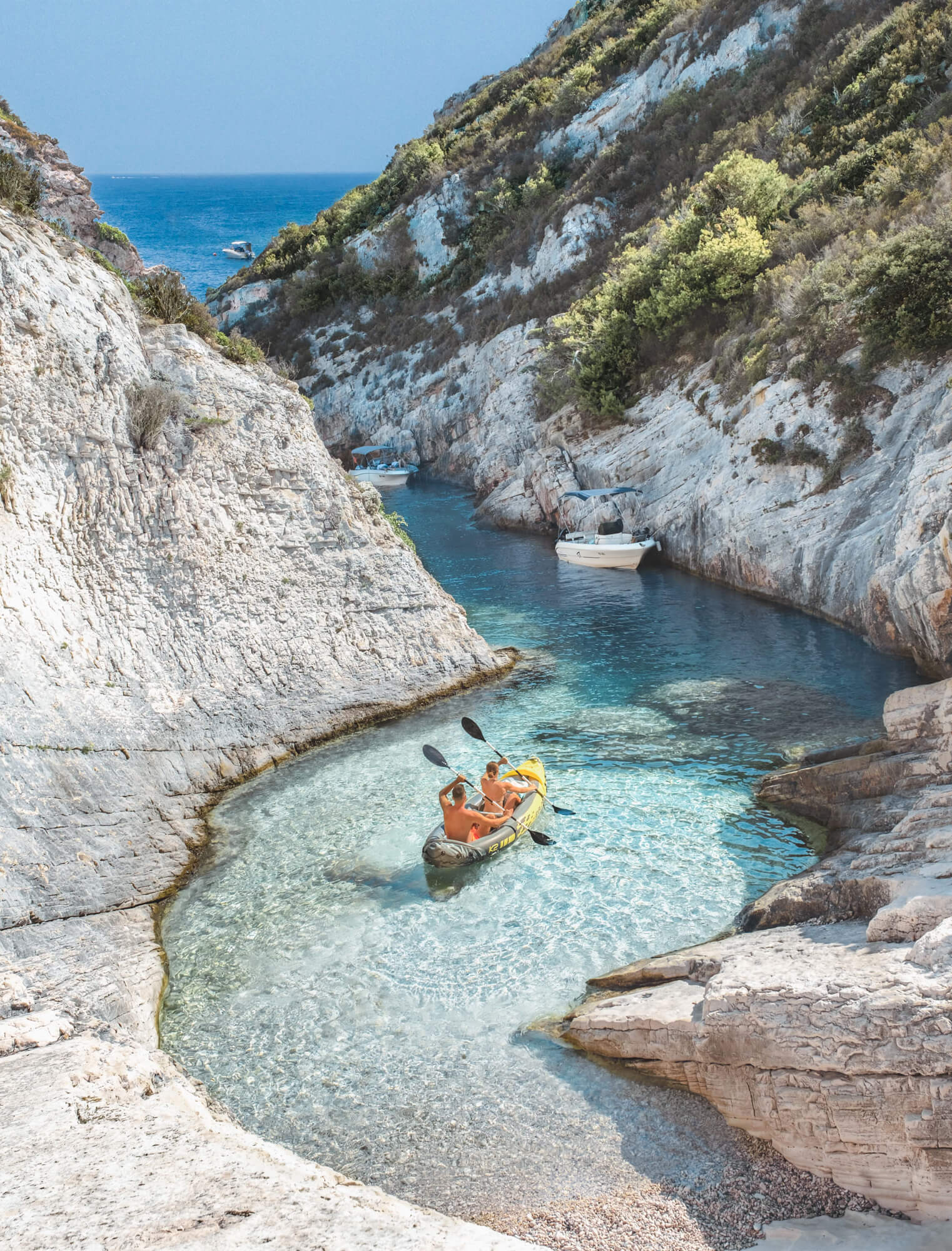
Pritišćina beach, Vis Island (Photo: Timotej Gošev)
Your talent as a photographer, and your Instagram account, have resulted in many collaborations over the last few years. What’s your favourite one so far? Is there one you would really love to do in the future?
It’s hard to pick a favourite. I love them all. This past summer I did a collaboration with Valamar Hotels. Had the chance to visit all their hotels across Croatia over a period of 6 weeks. It was amazing. Shooting the hotels, rooms, beaches in front of the hotels. The facilities. Loved every second. The sailing collaborations are always unforgettable too. What would I love to do? Shoot Villa Sheherezade in Dubrovnik. Or shoot a mega-yacht in Croatia. I dream big.
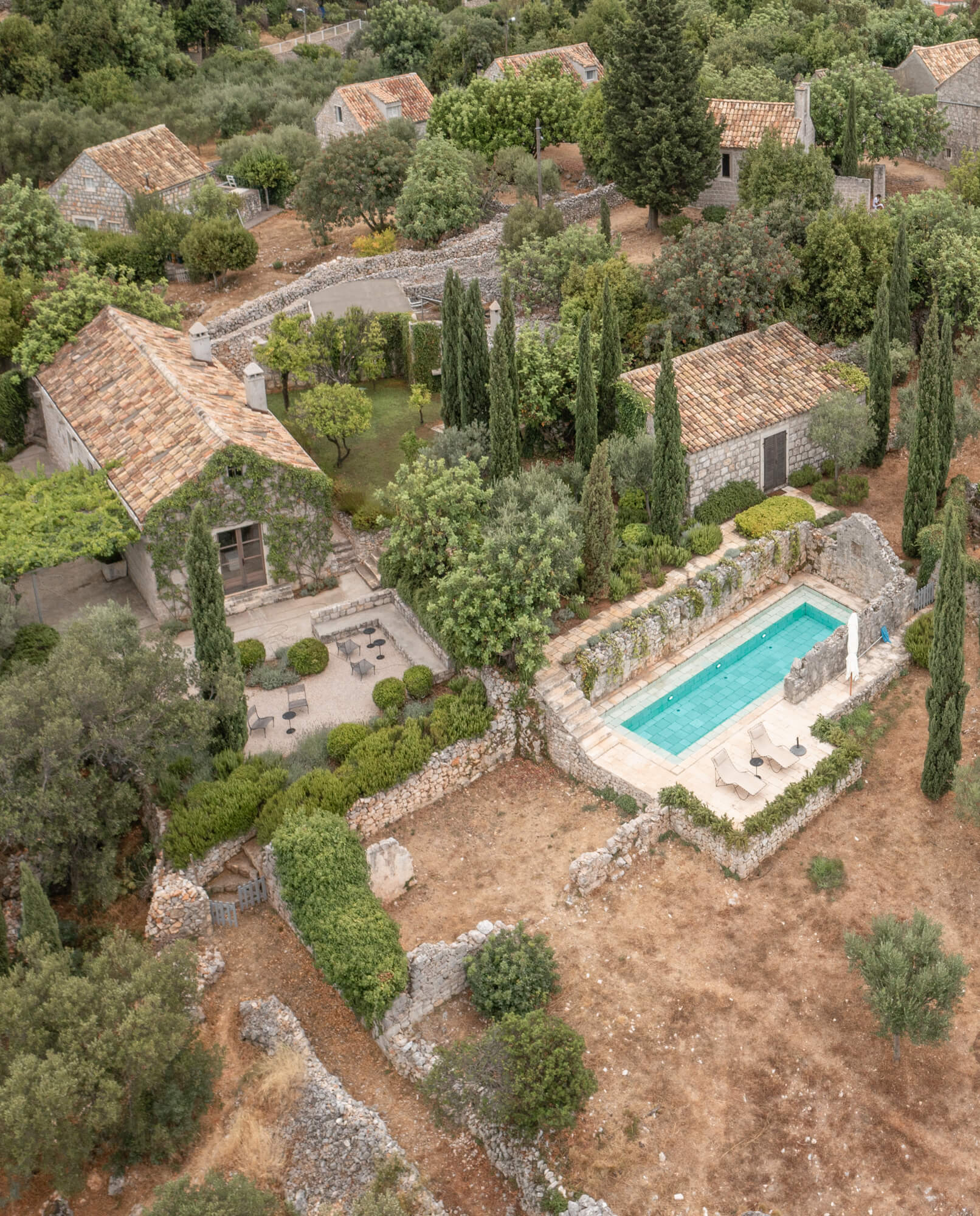
Lopud Island (Photo: Timotej Gošev)
Finally, are you planning to ever move to Croatia permanently?
If you ask me, “Timotej, would you like to live in Croatia one day?” The answer is obviously going to be a definite yes, yes I would. However, I wouldn’t want to live there throughout the whole year. I can see myself living there between April and October. I’m the type of person who dreams of having multiple homes. At least two in two different countries. But in life, you should also never say never. If the right opportunity arises, who knows, I might end up living in Croatia all year long. Living there would give me the chance to photograph Croatia during all the seasons, and not just summer.
For everything you need to know before planning your next summer vacation in Croatia and all these magical destinations shown in this article, be sure to check Timotej's Instagram account and our new guide to everything Croatia, Total Croatia, here.
If you don't have Instagram, follow him on Facebook.
For more on lifestyle, follow TCN's dedicated page.
For more about Croatia, CLICK HERE.



